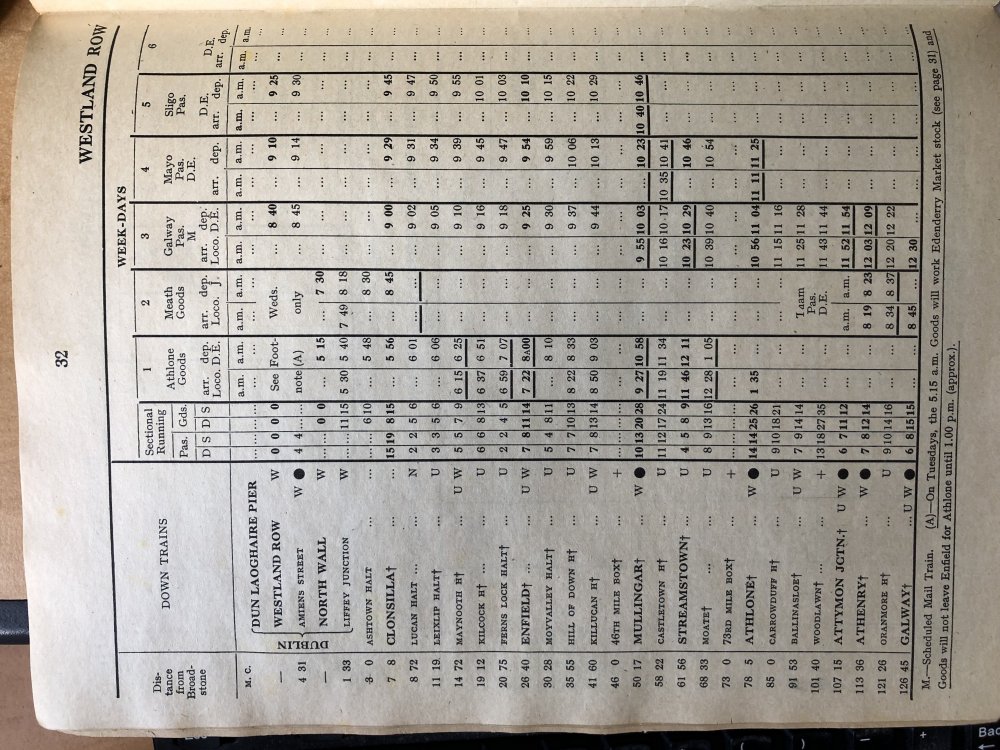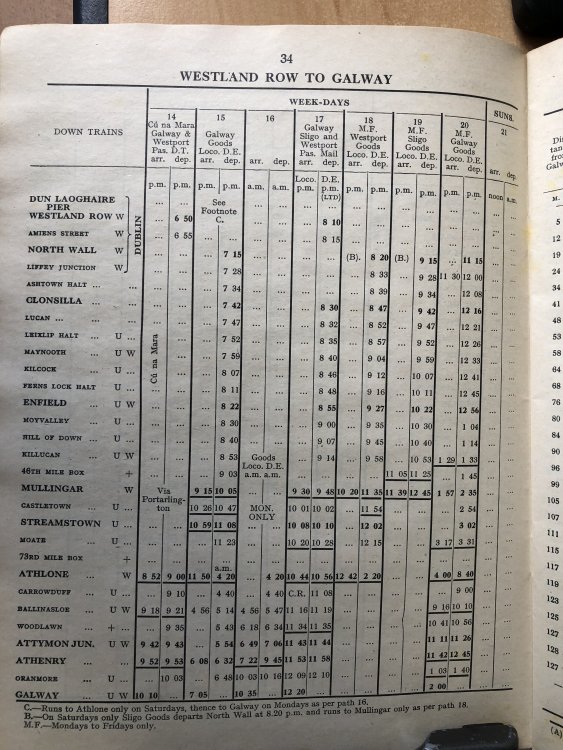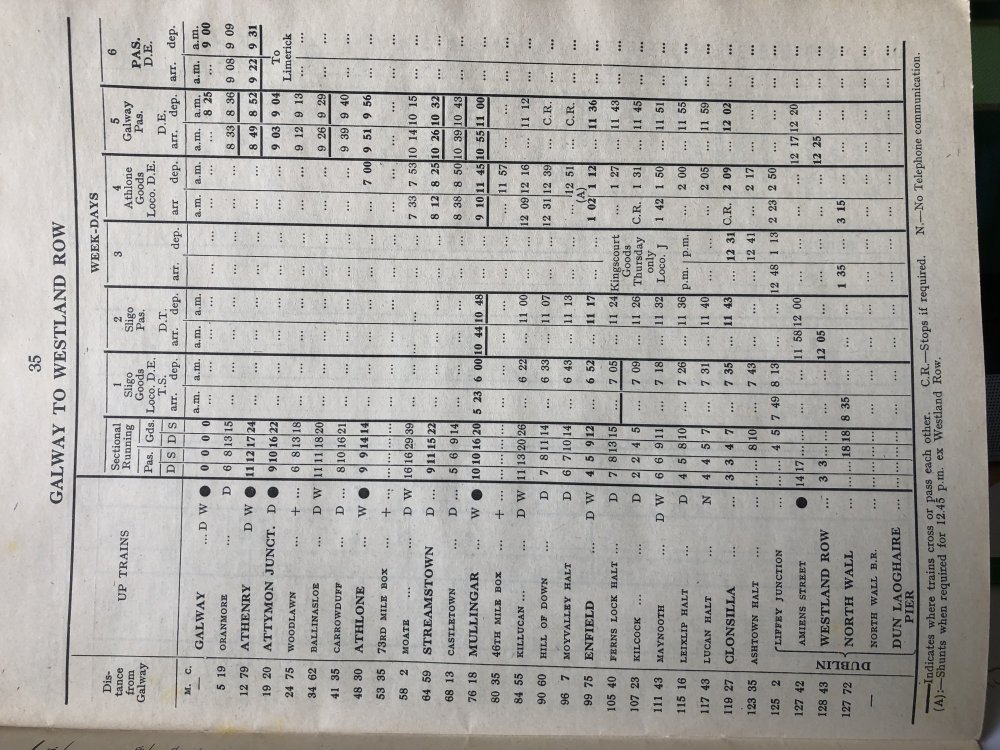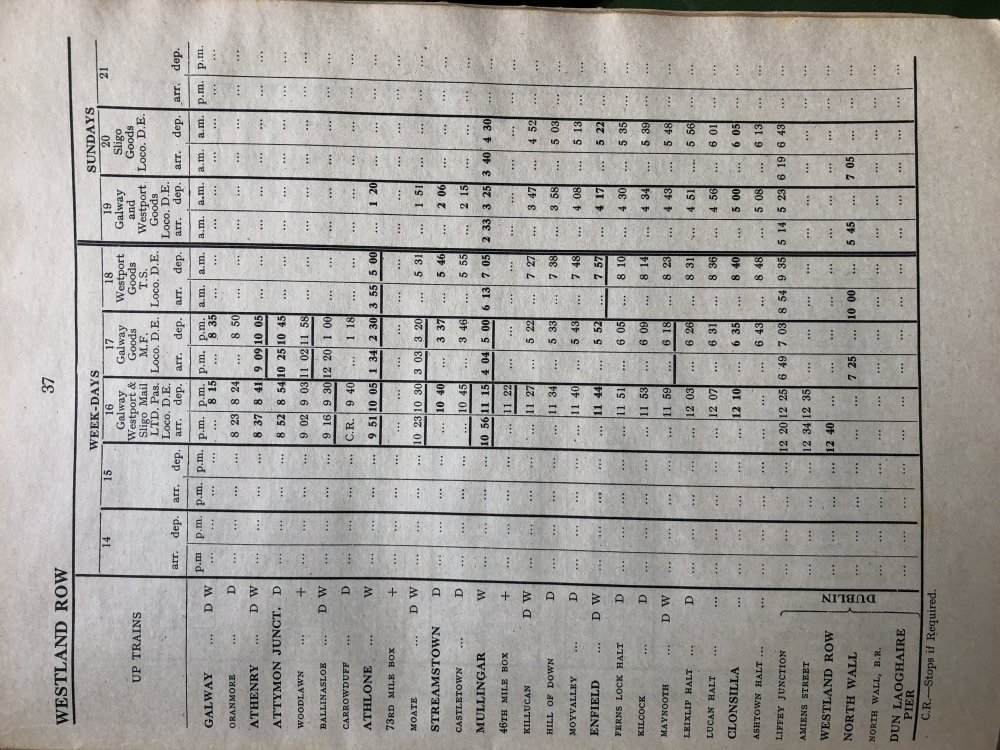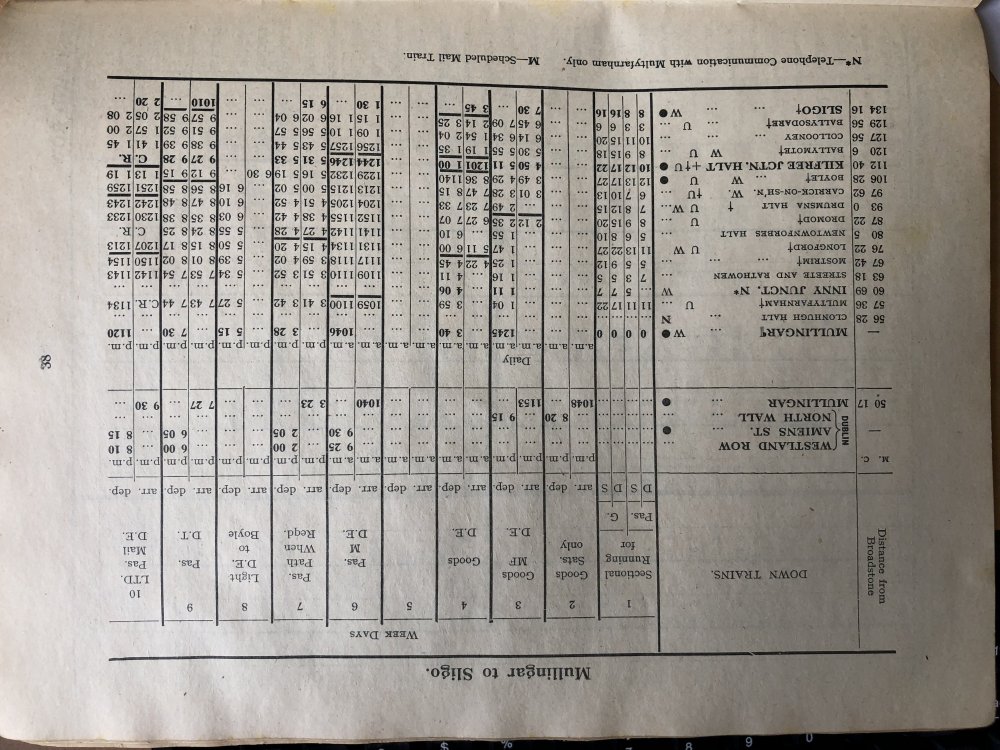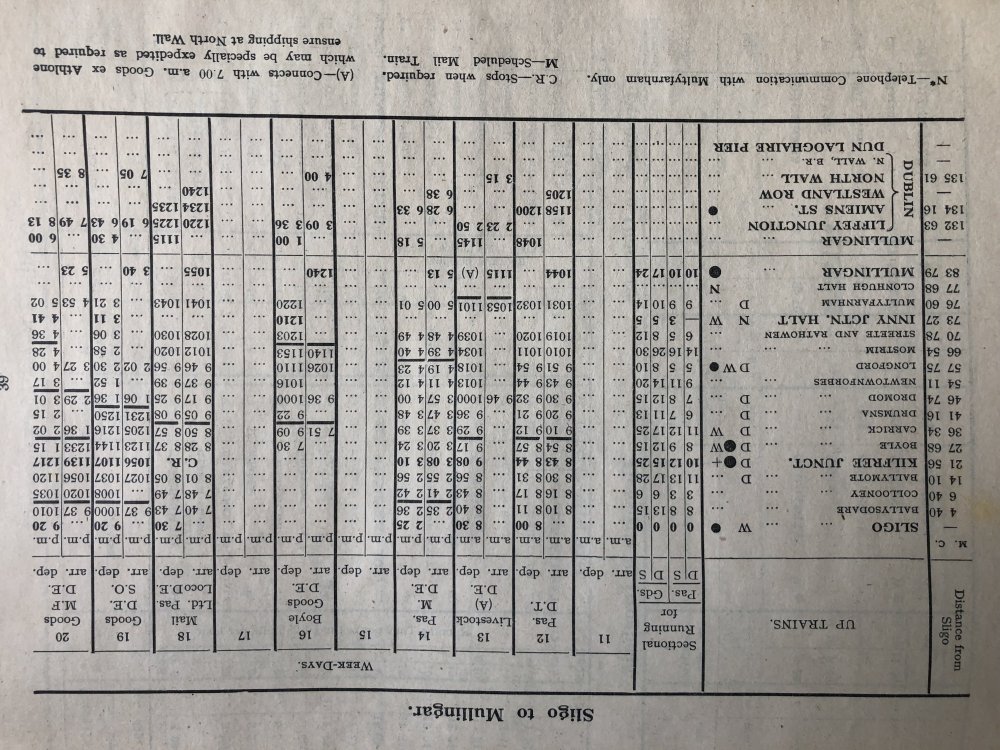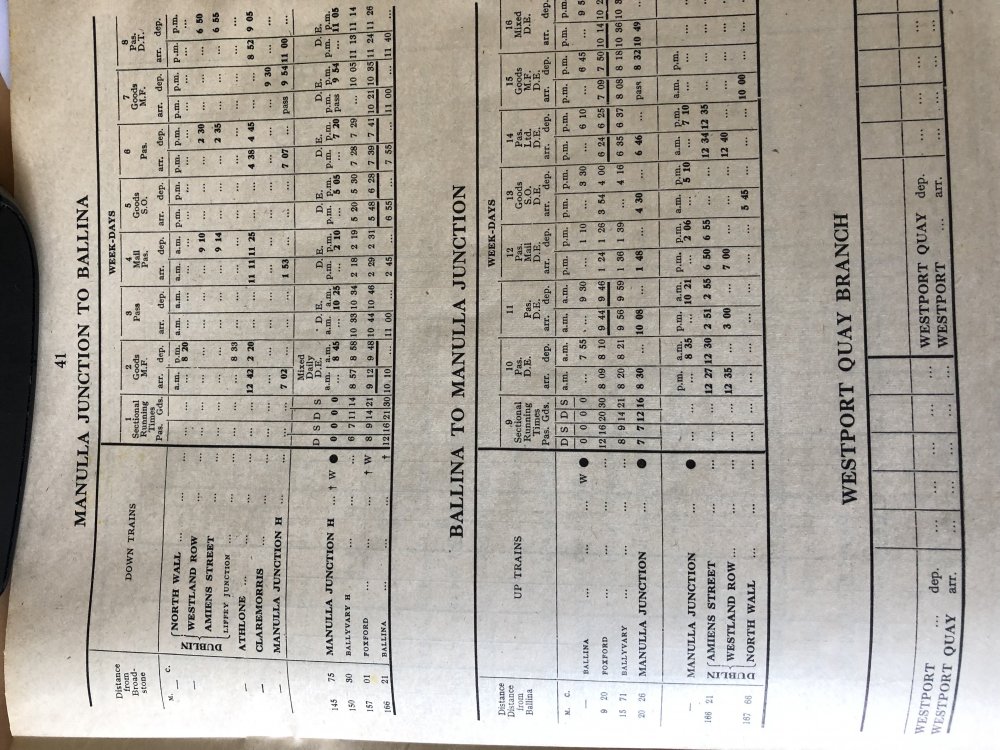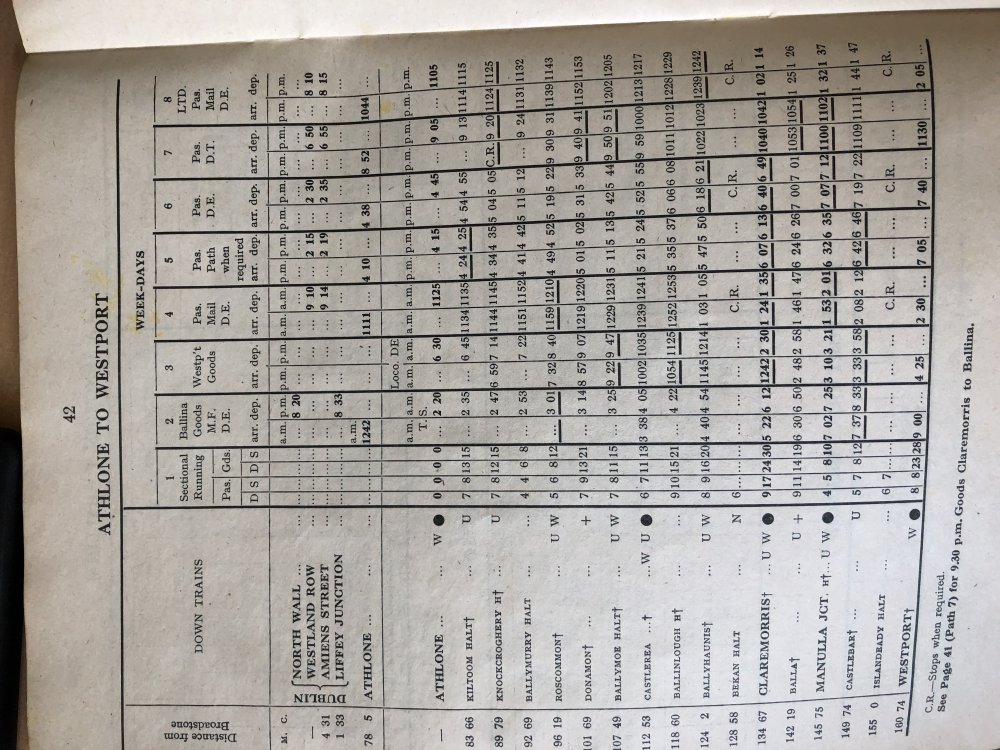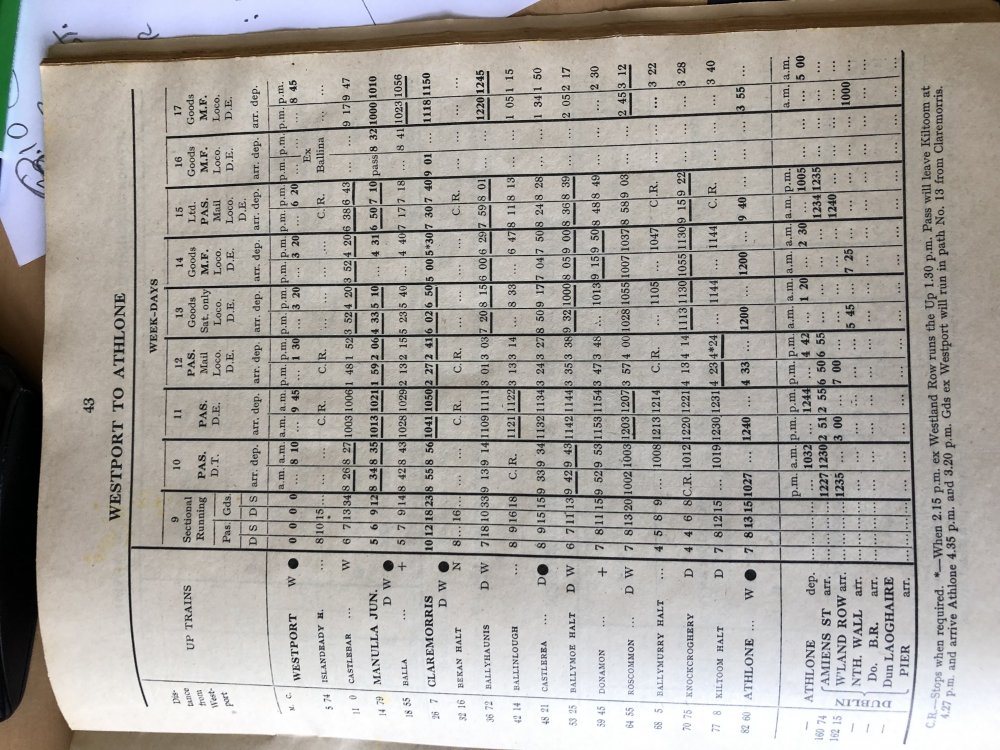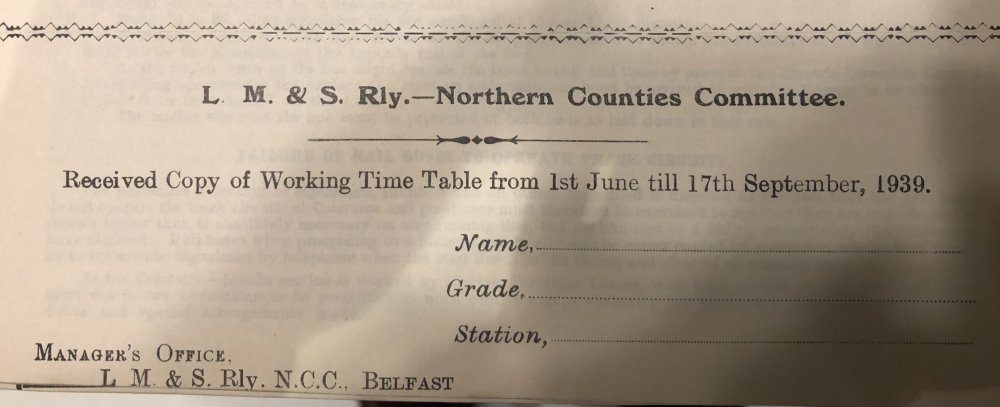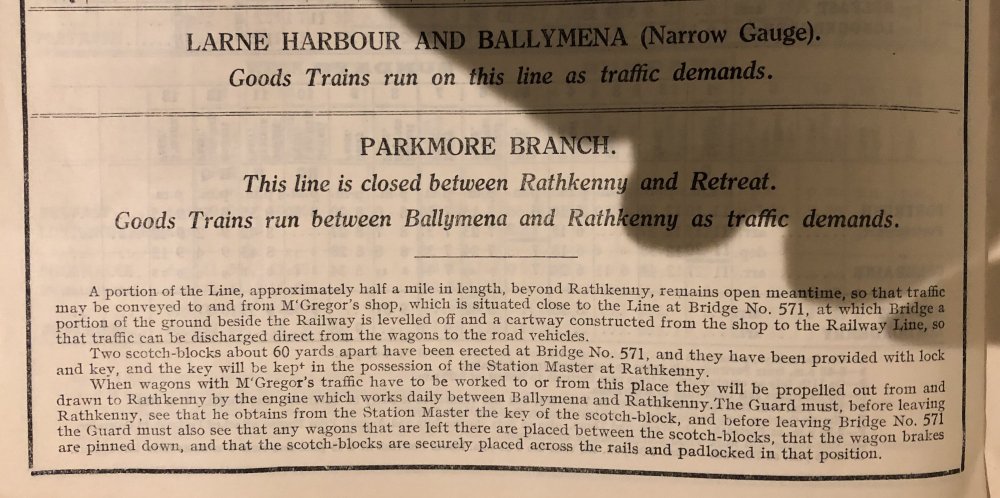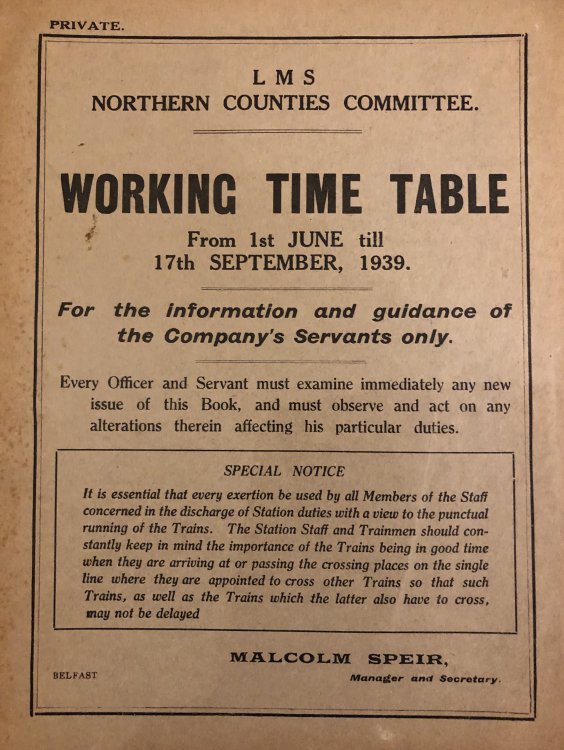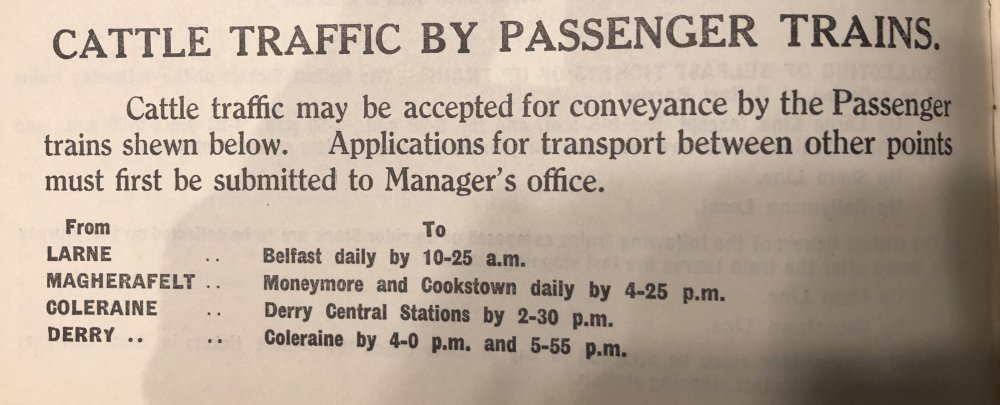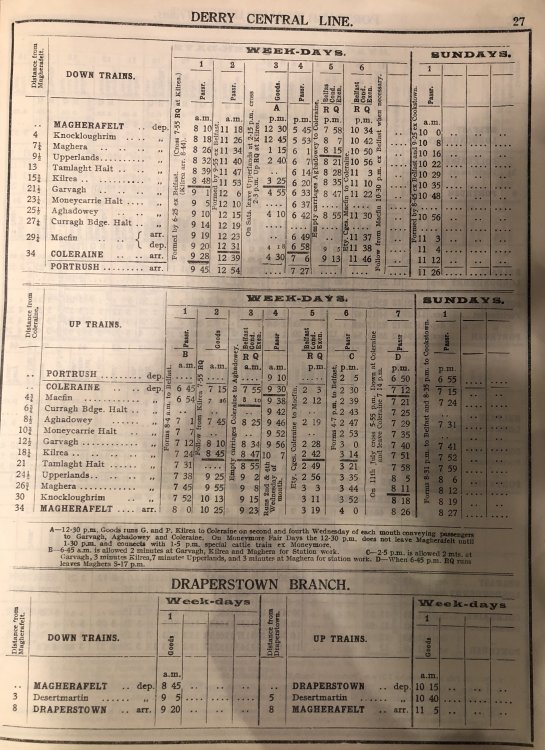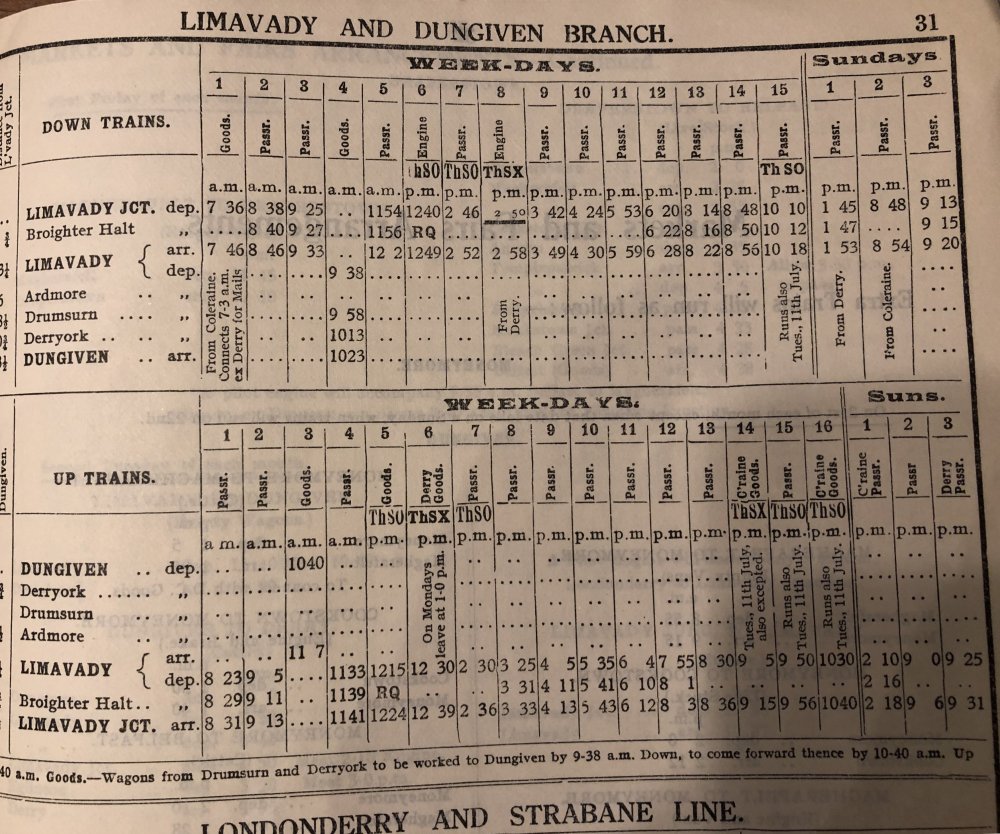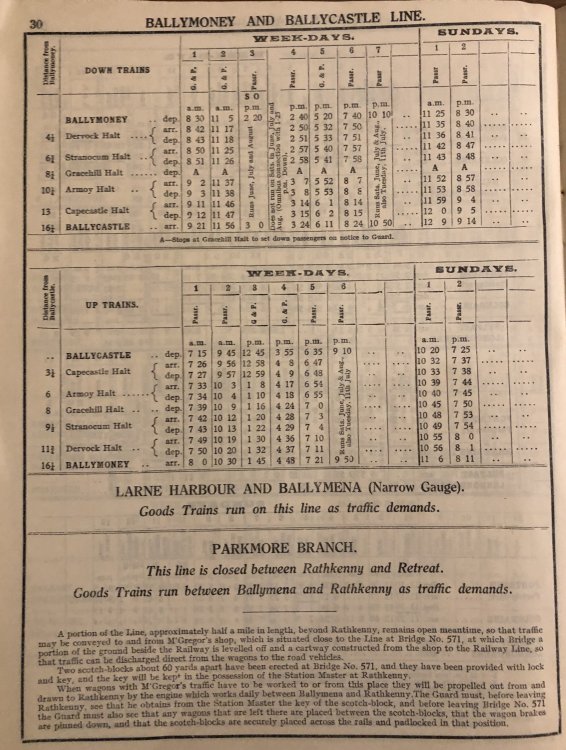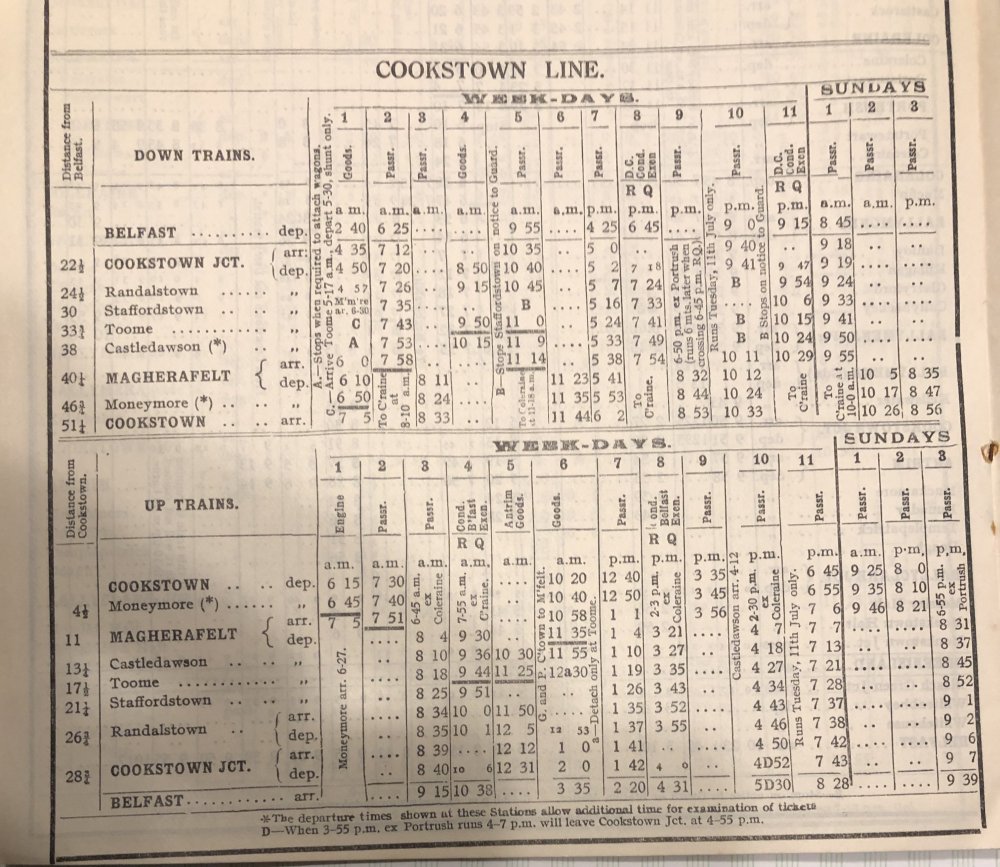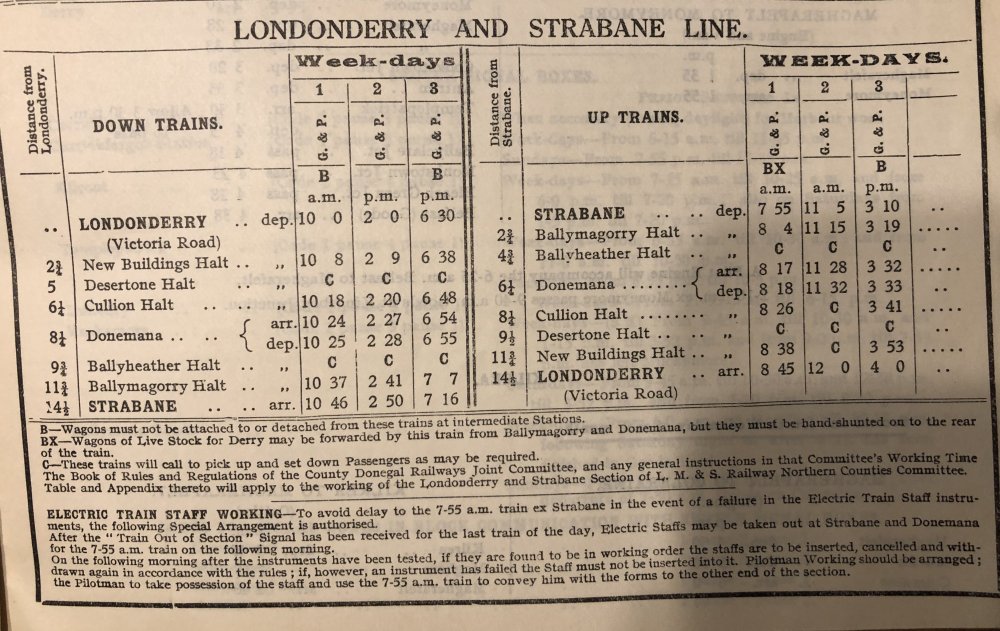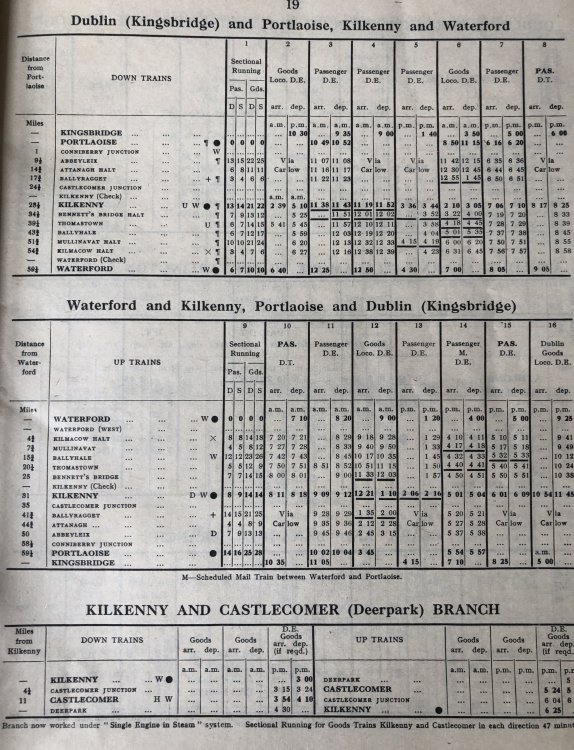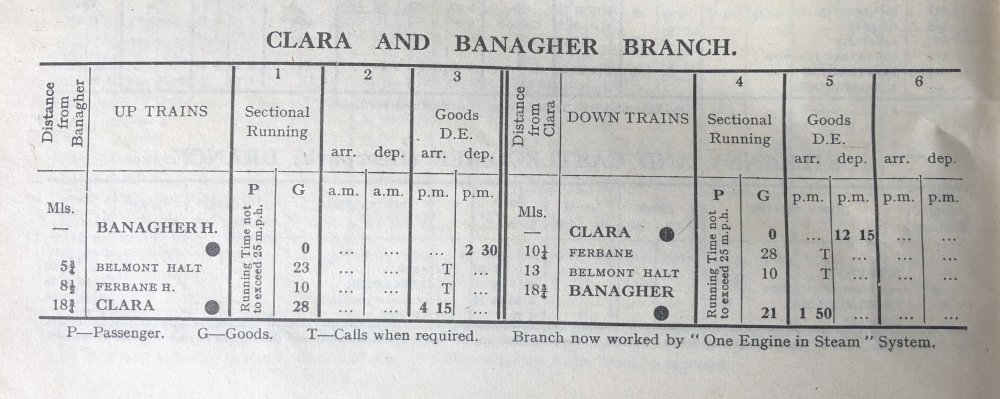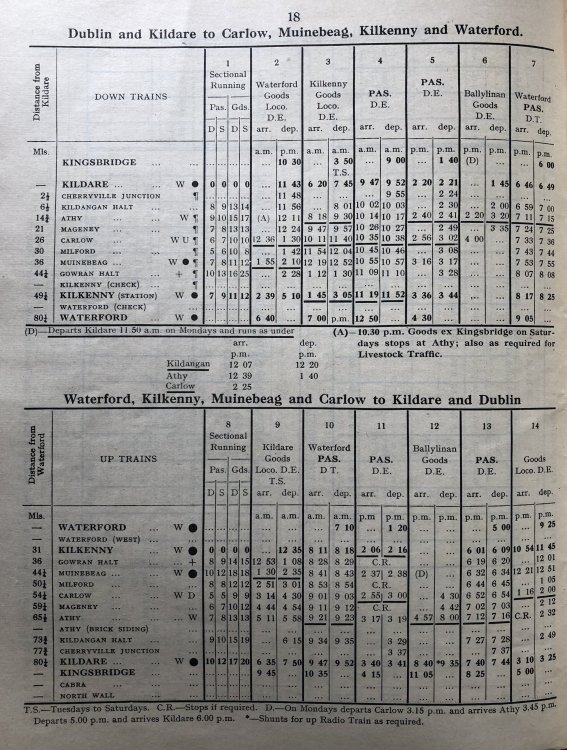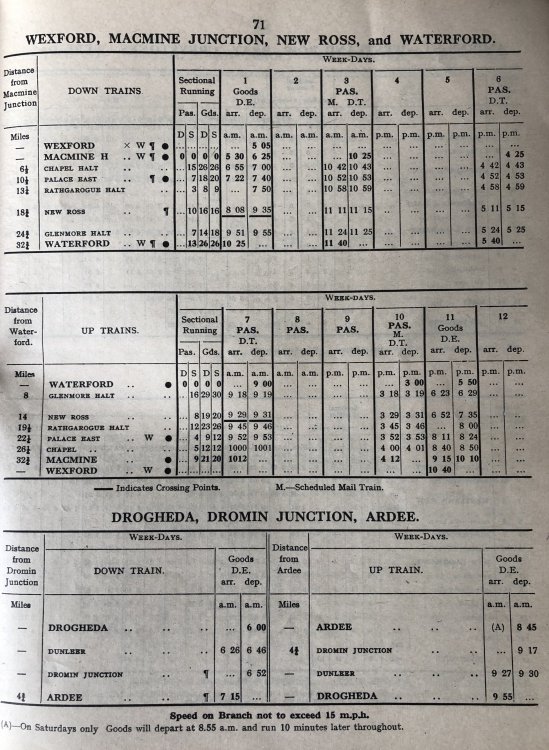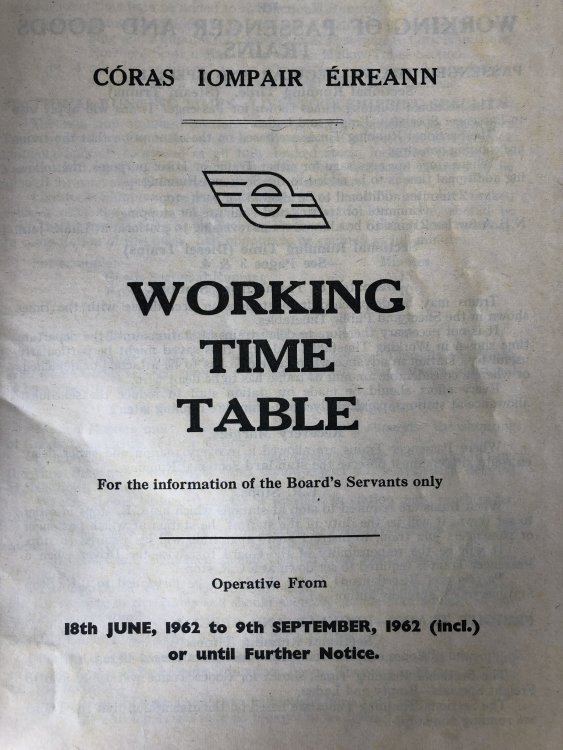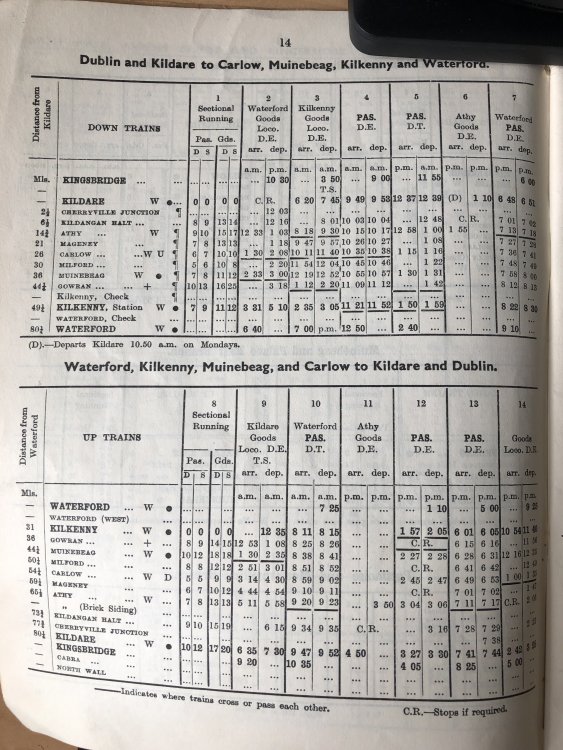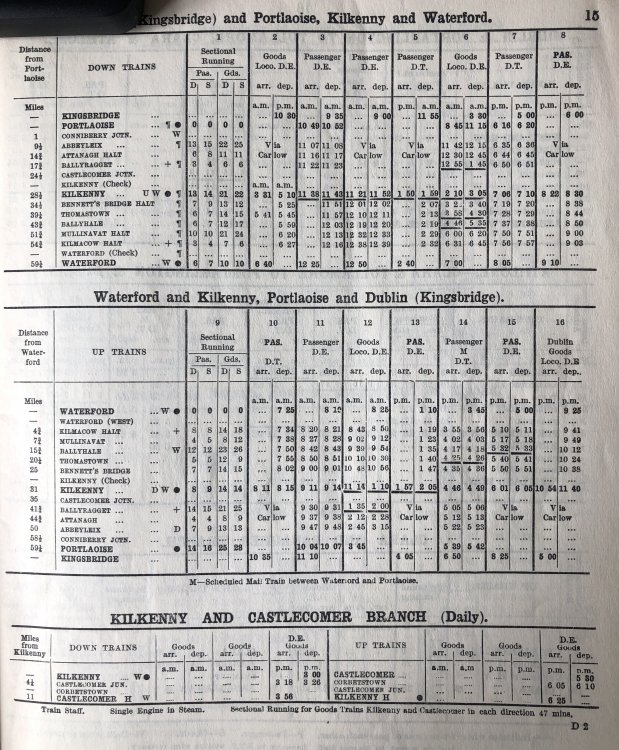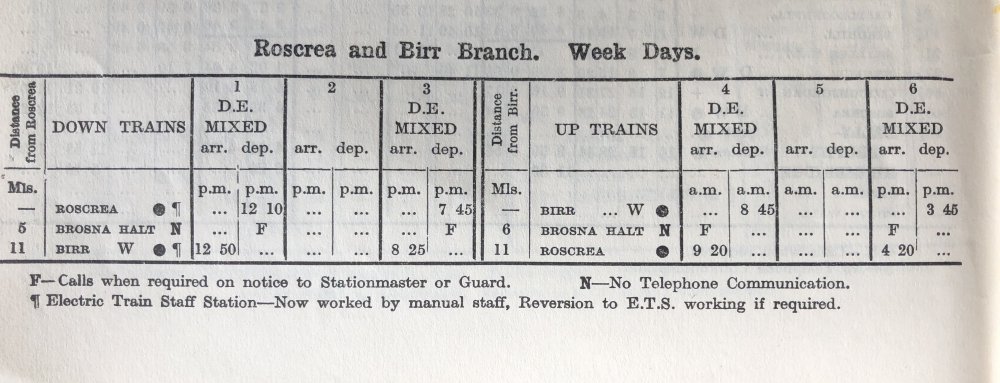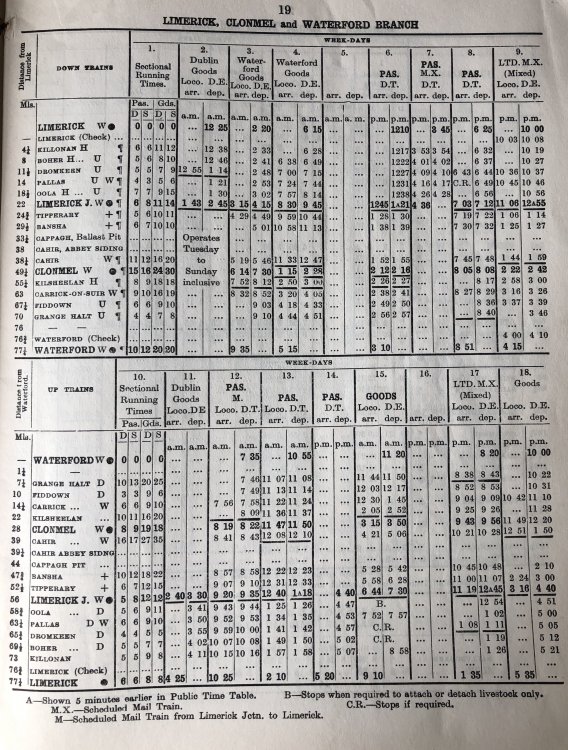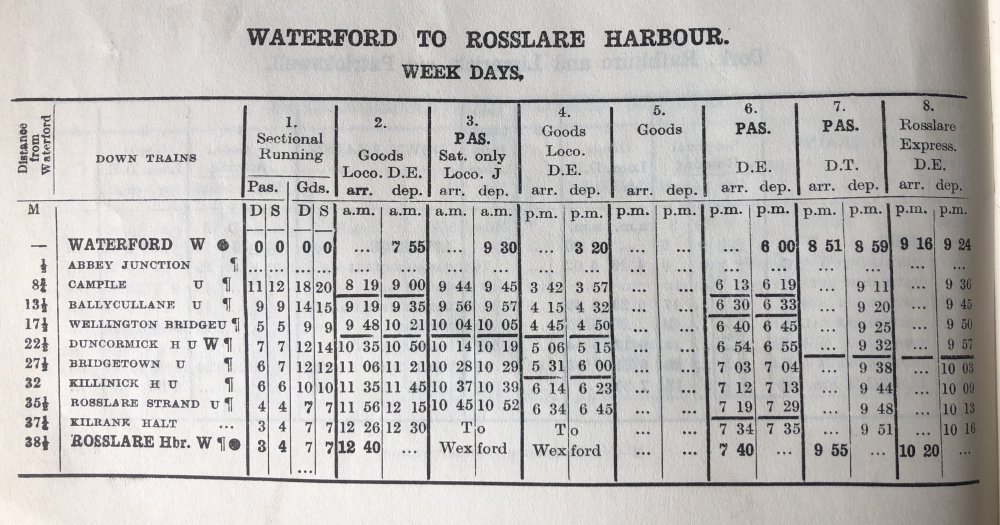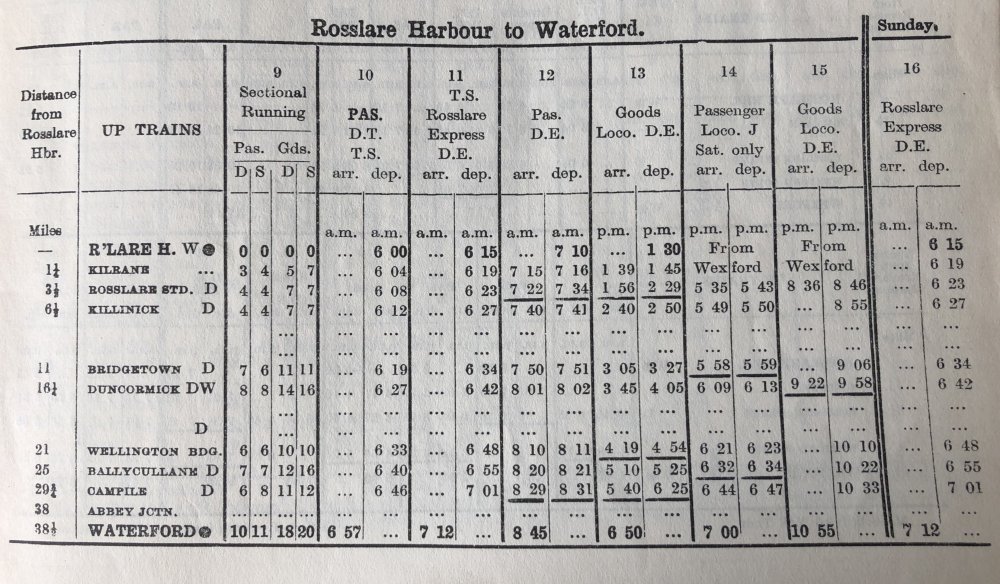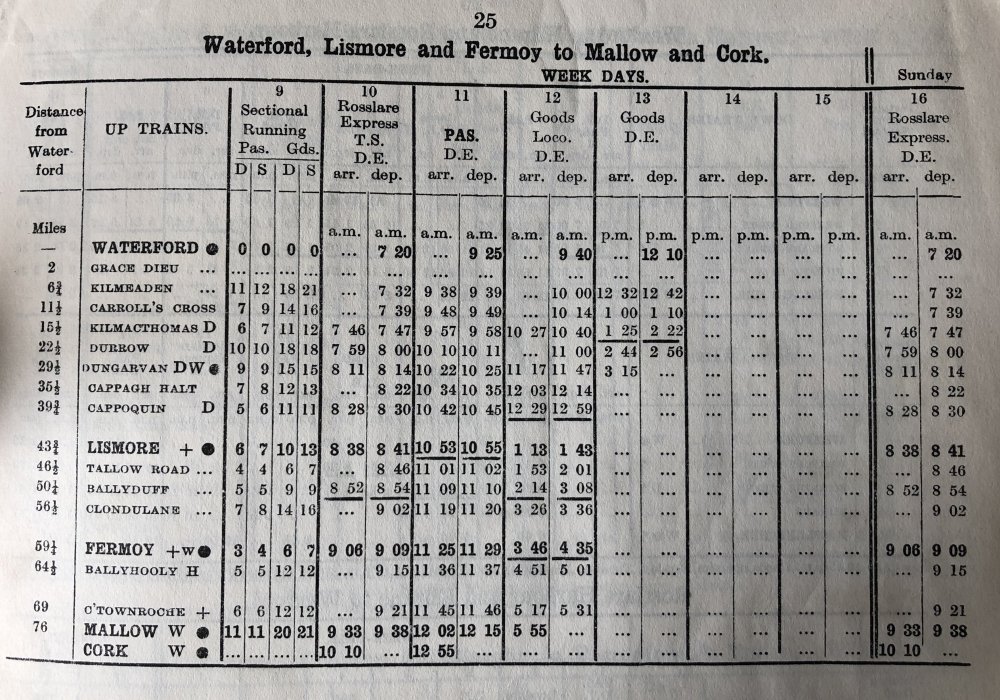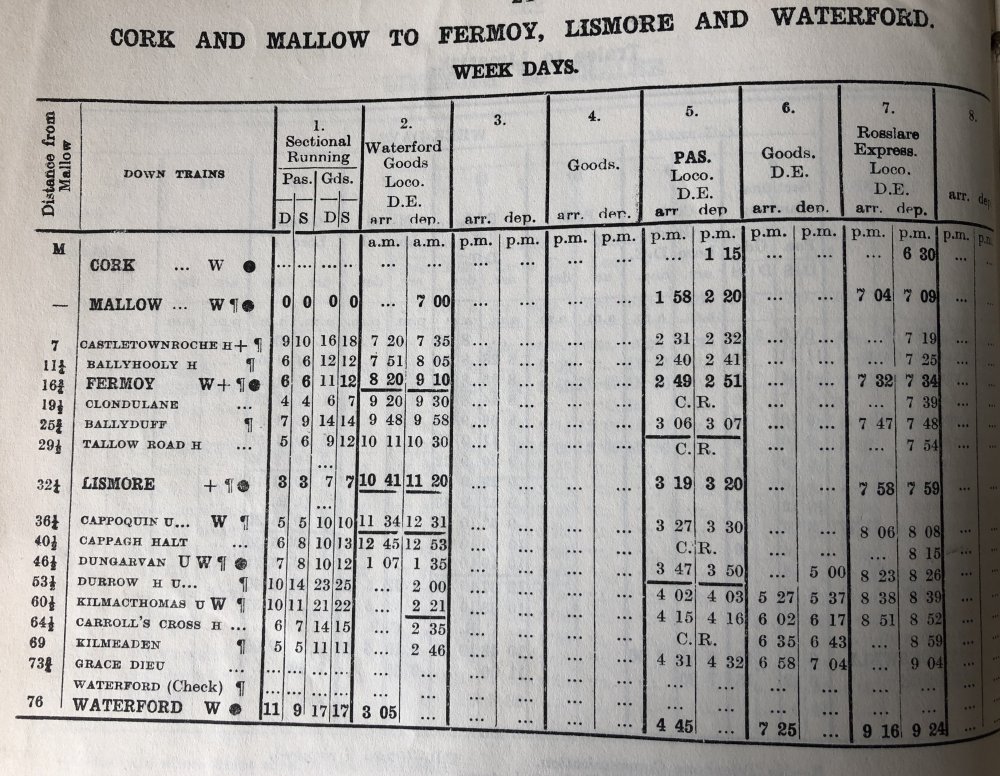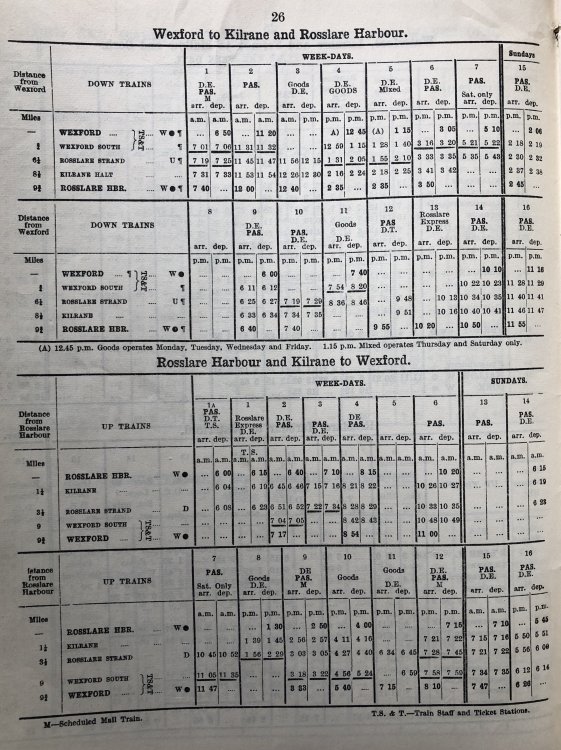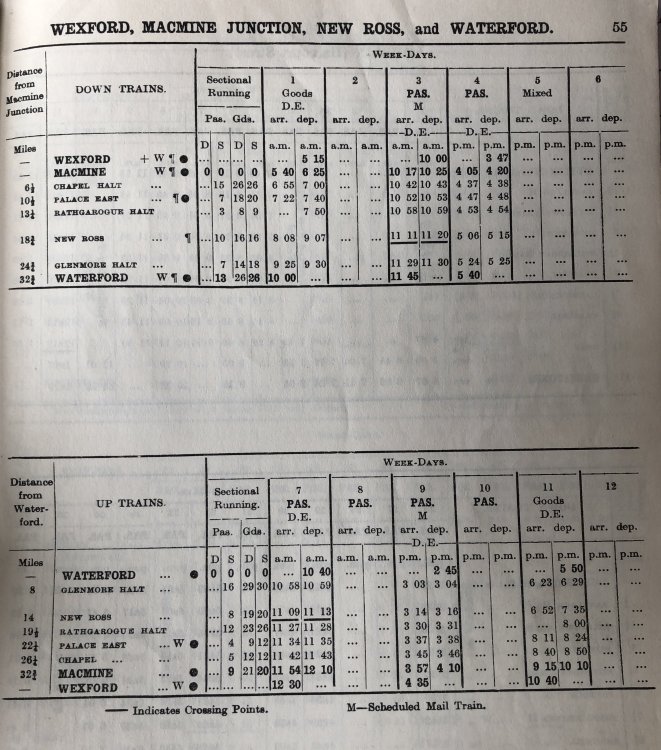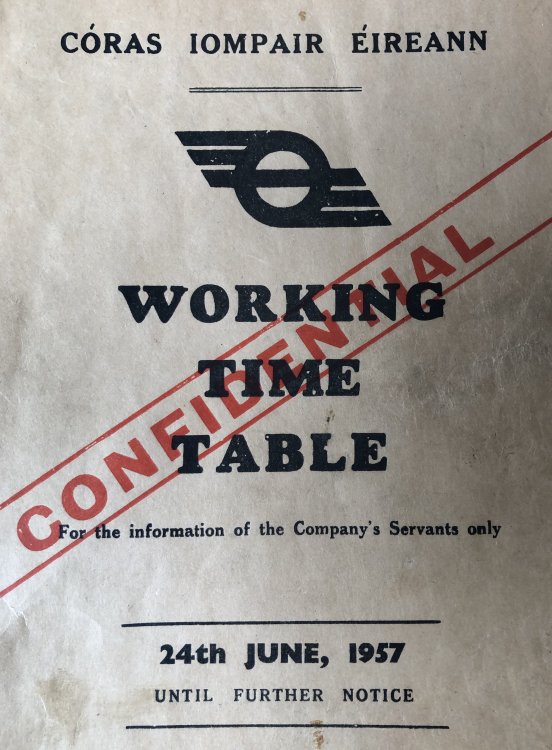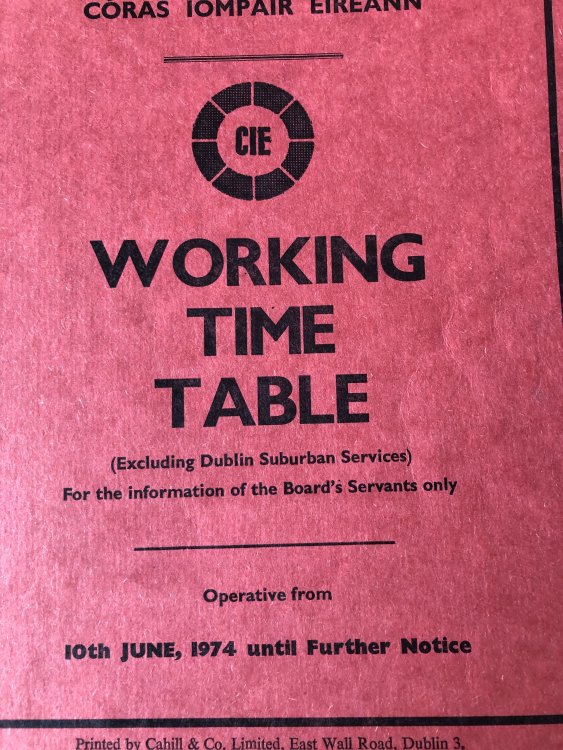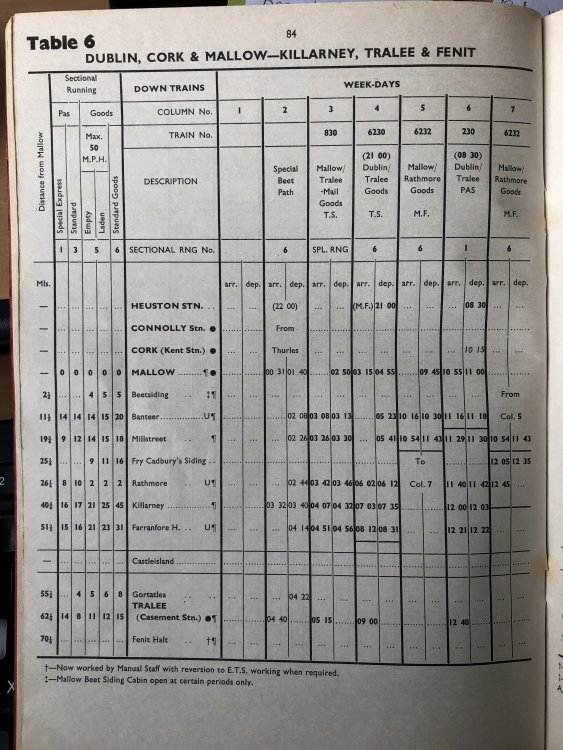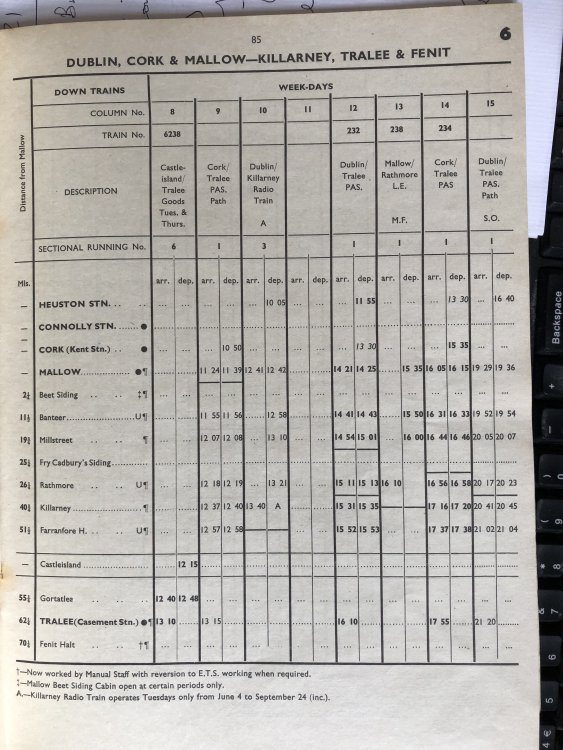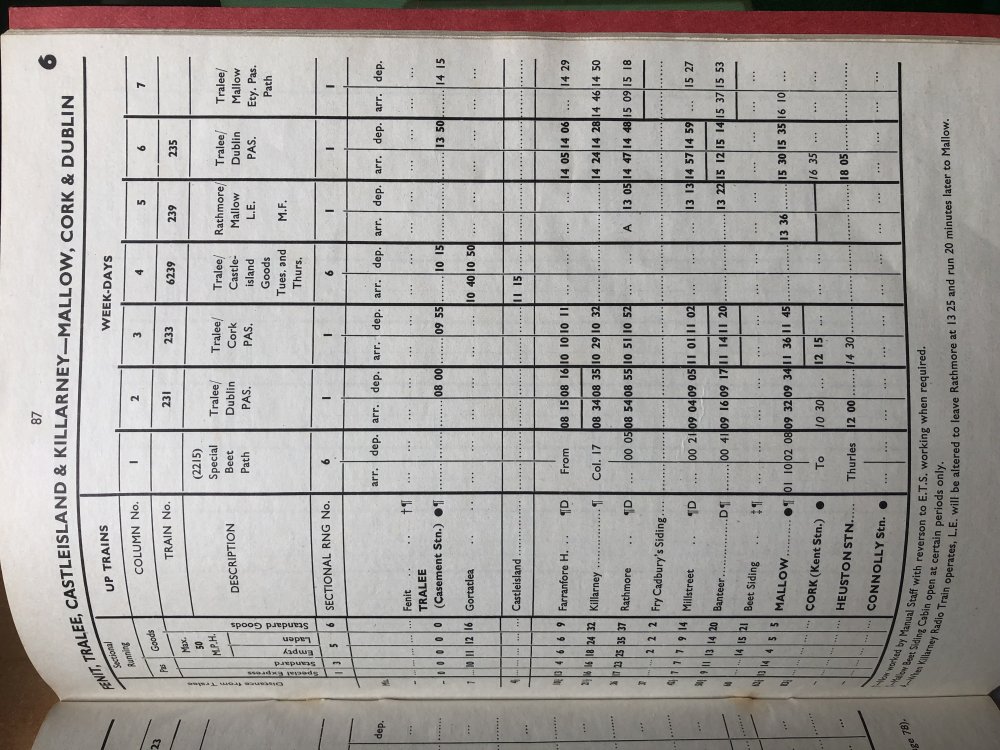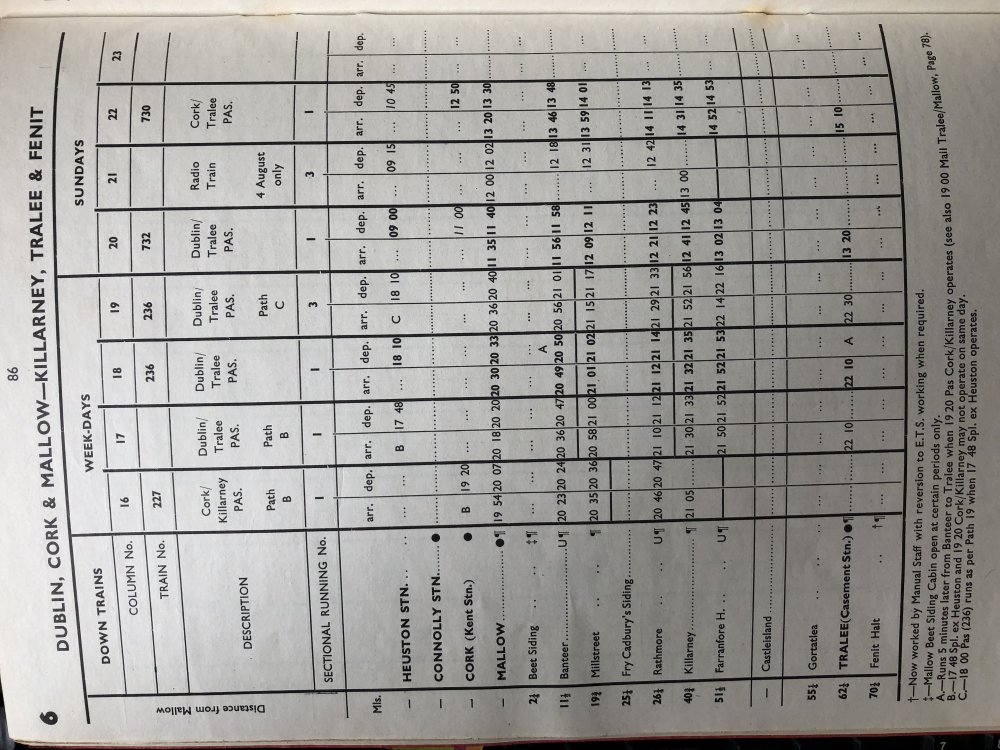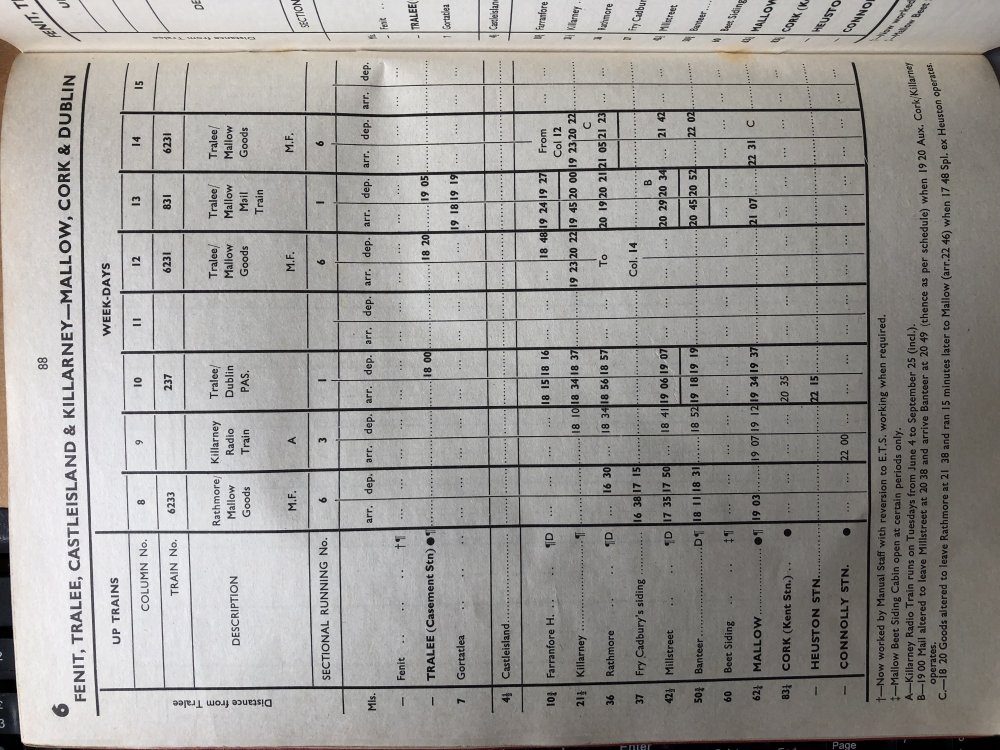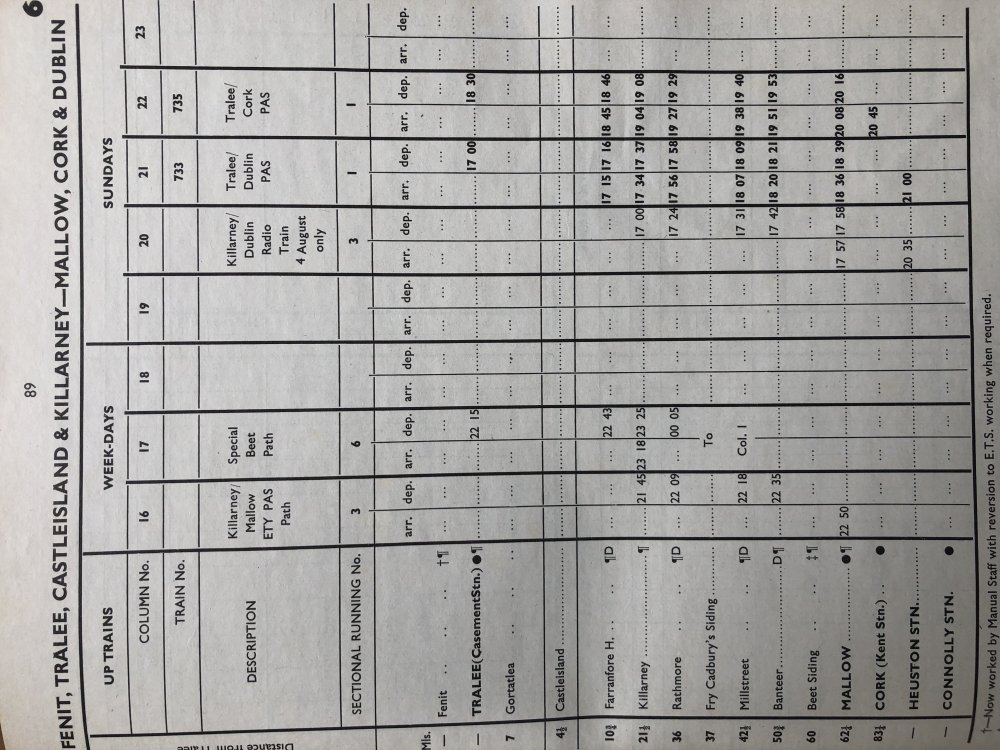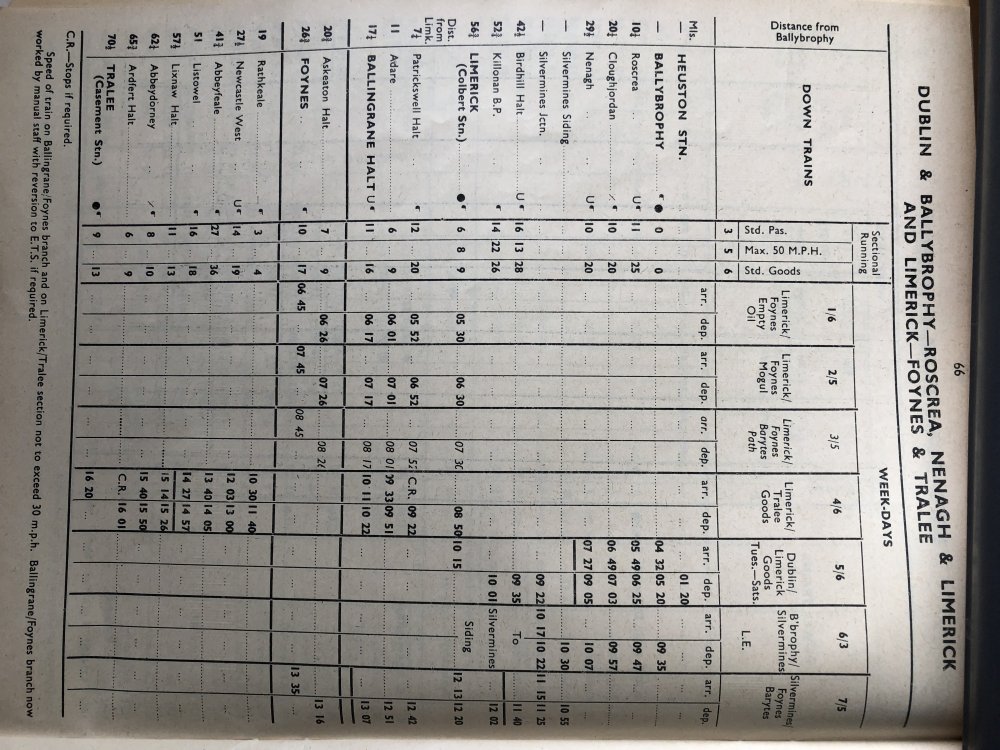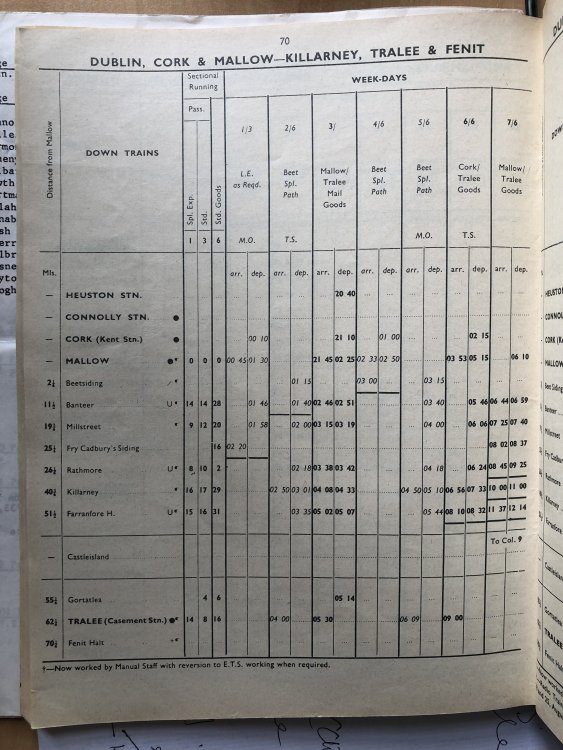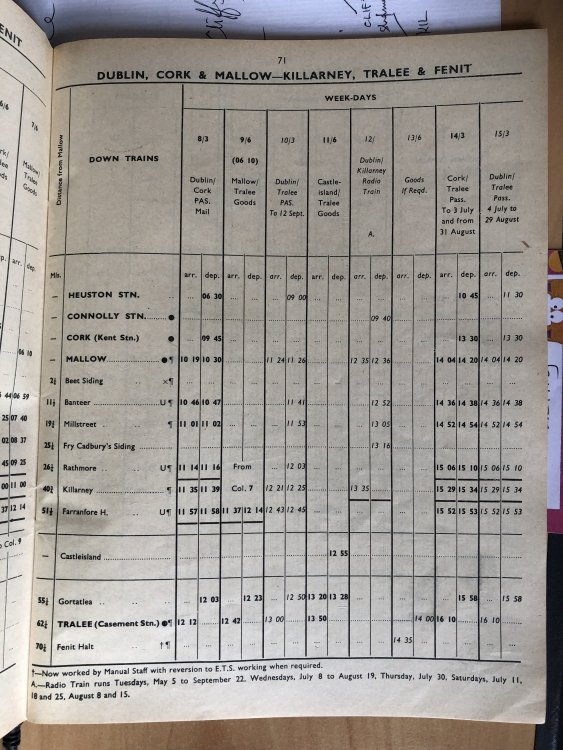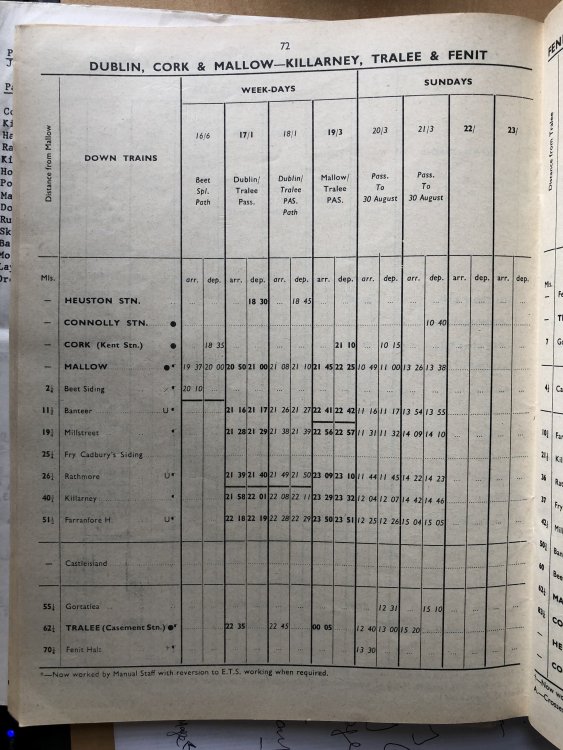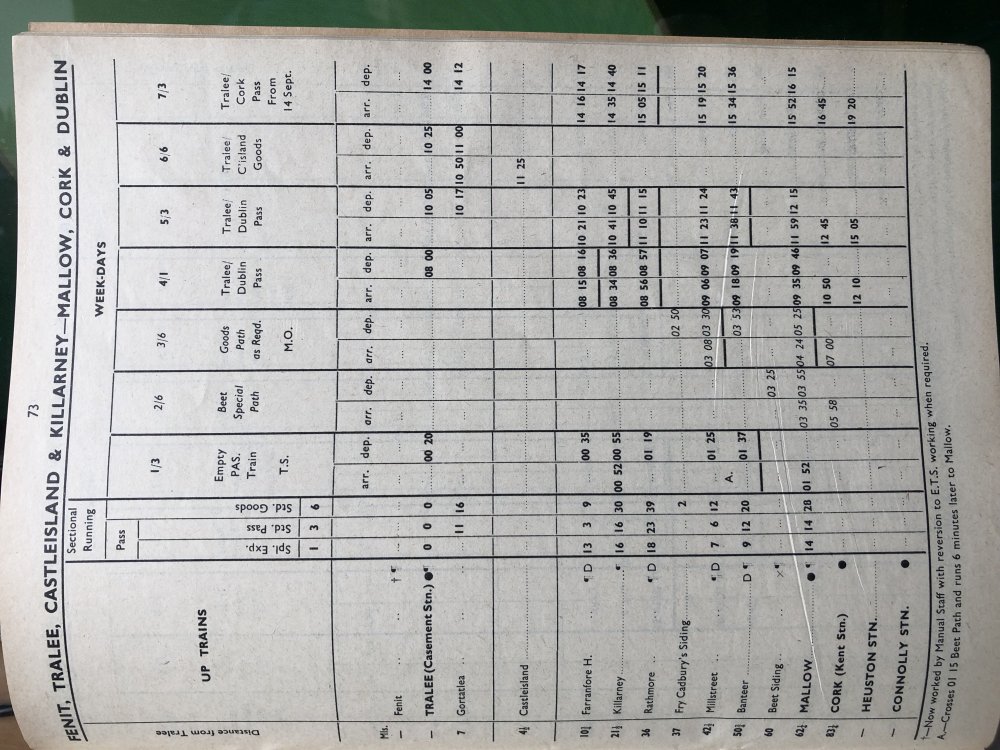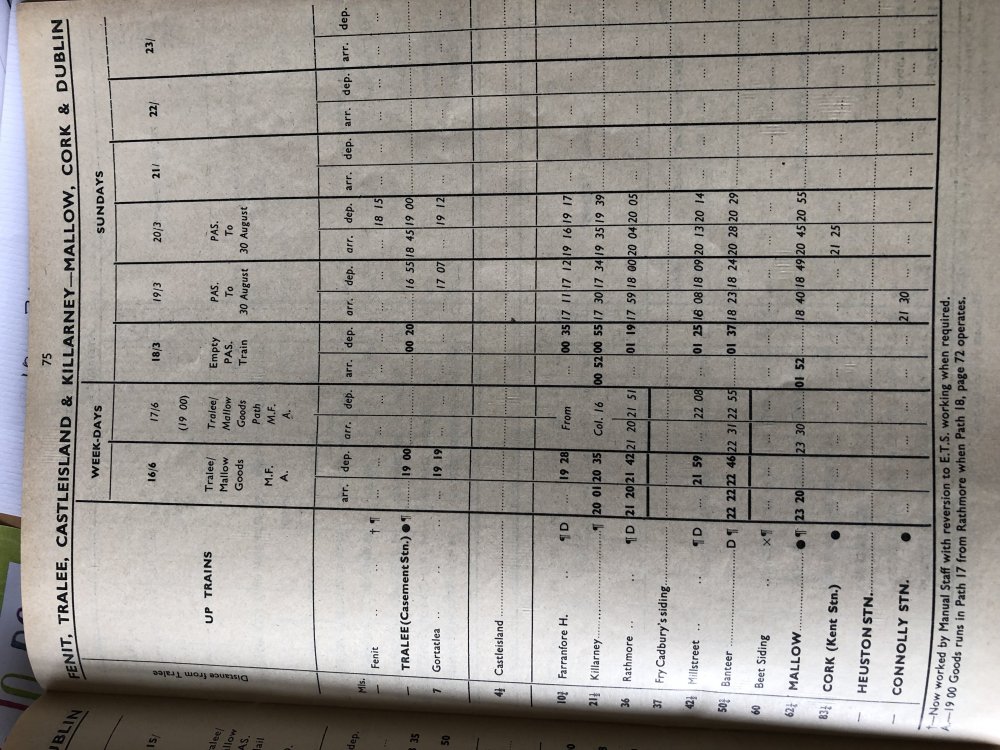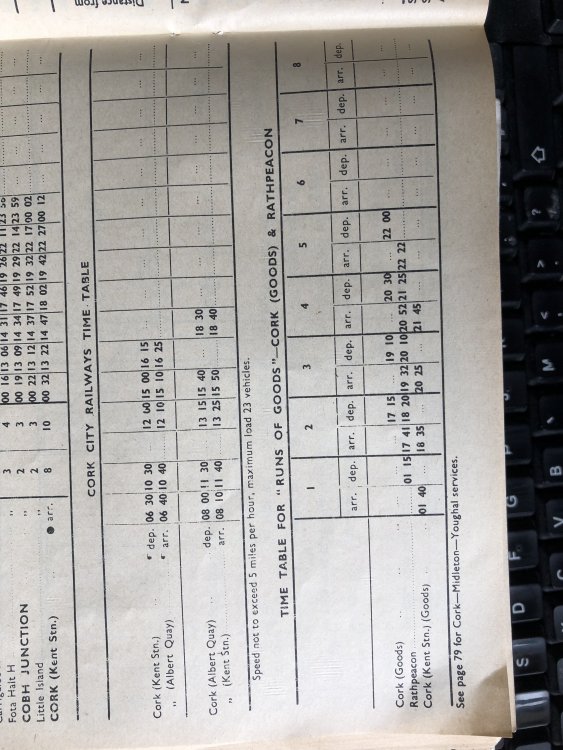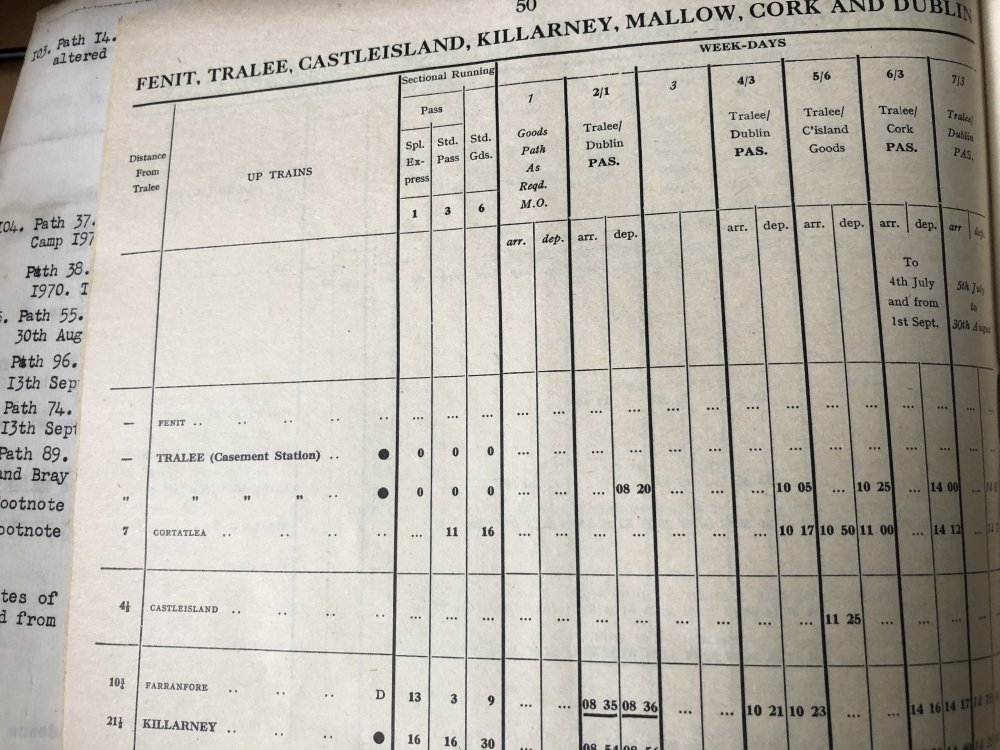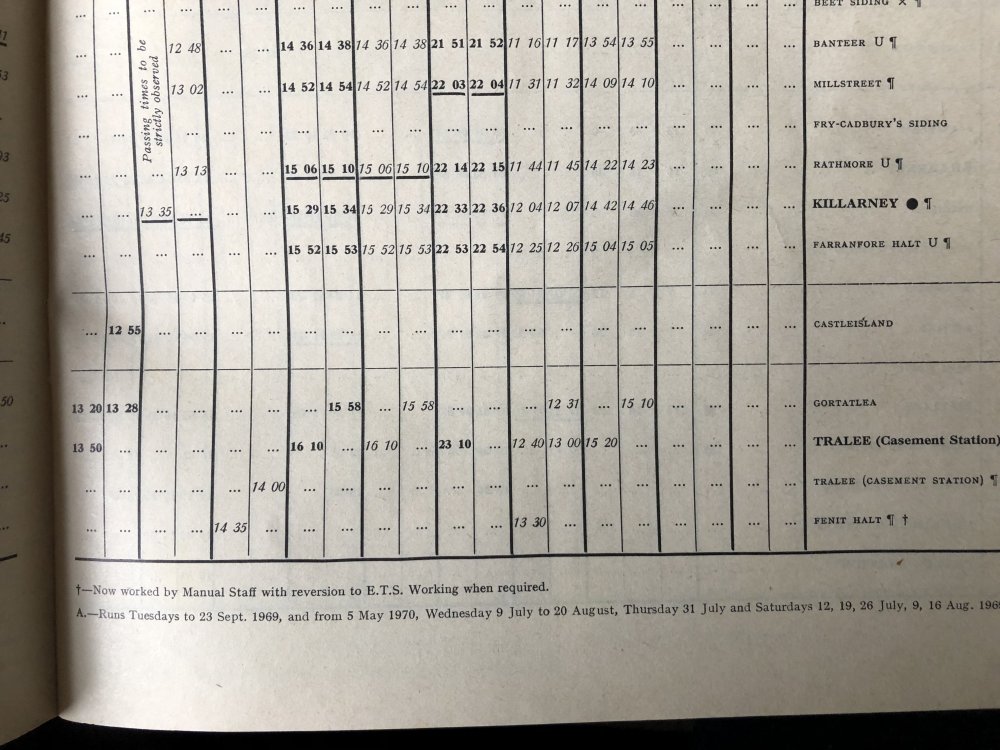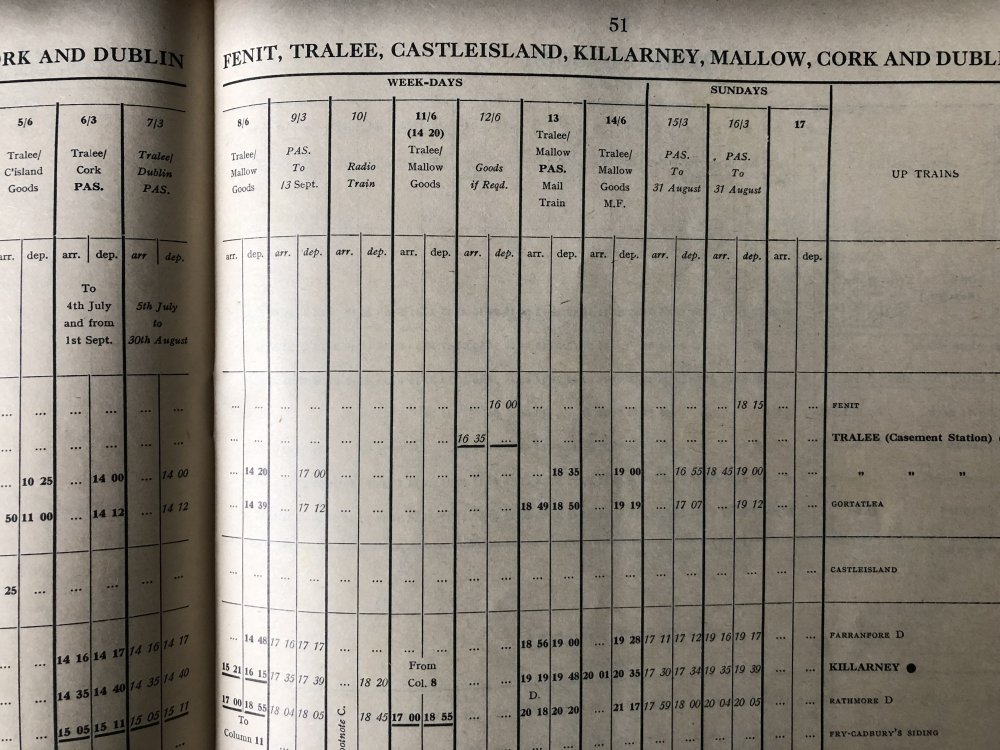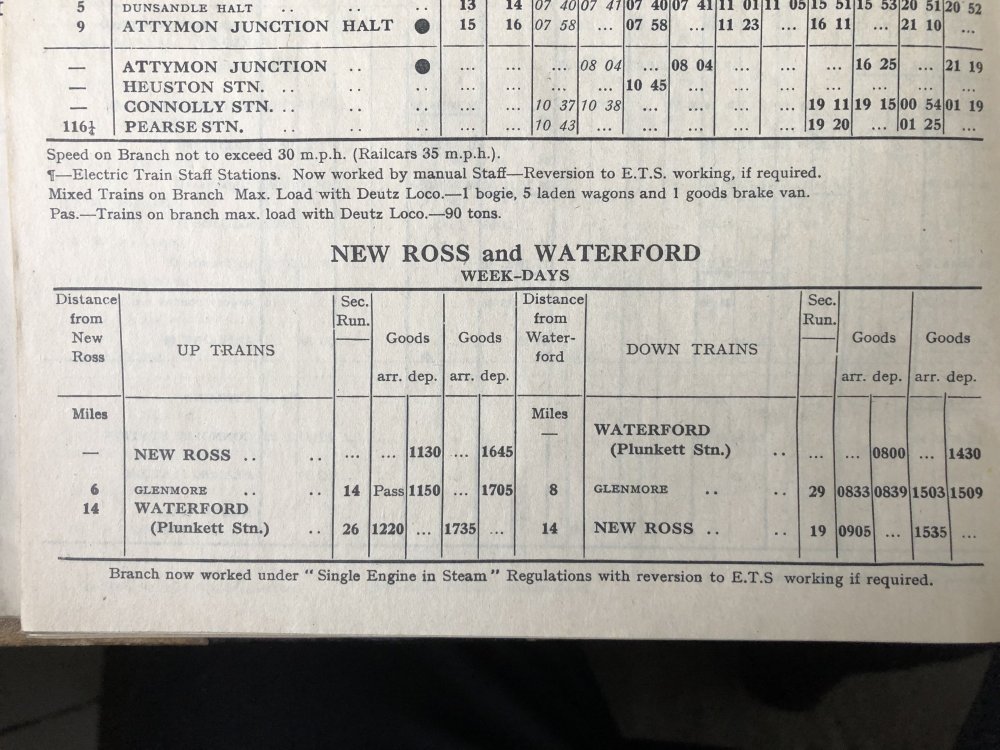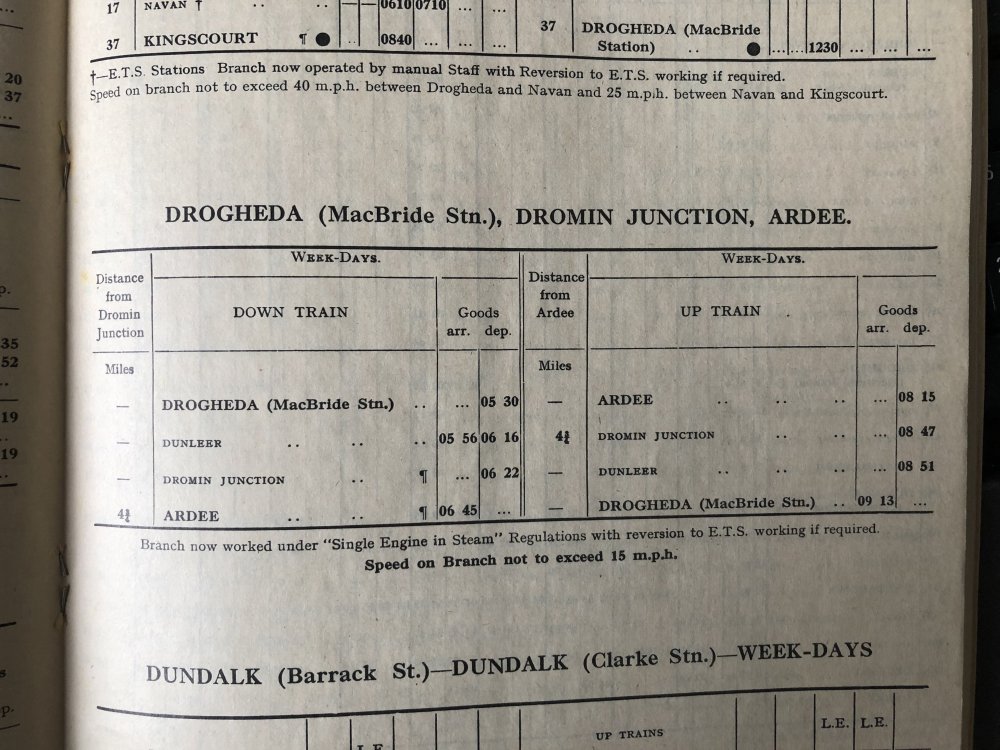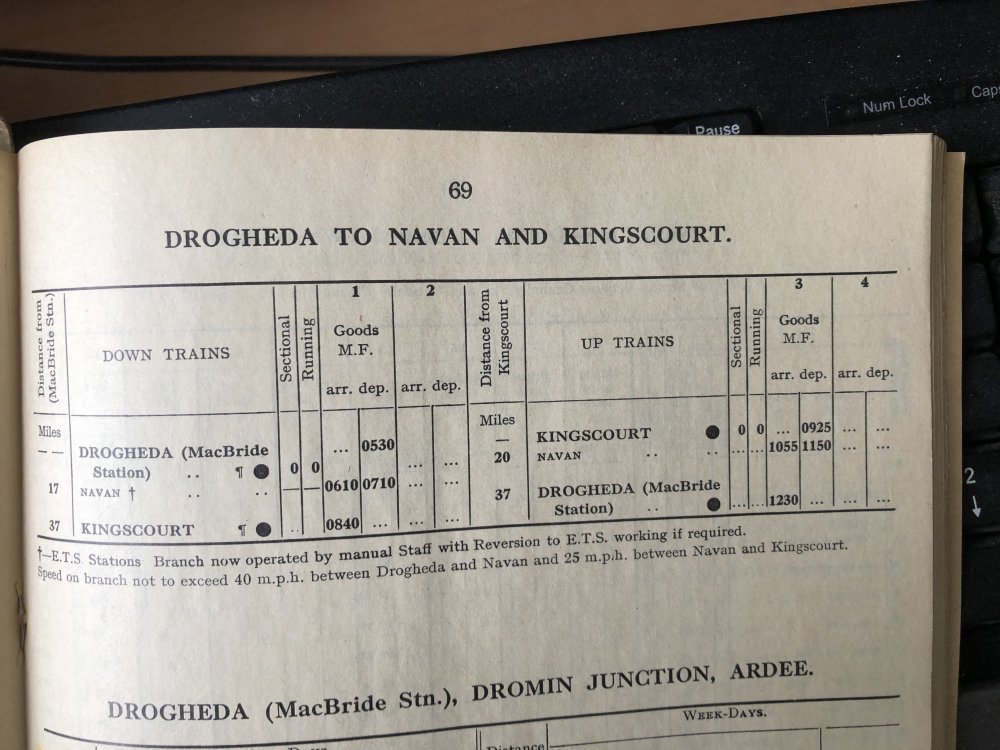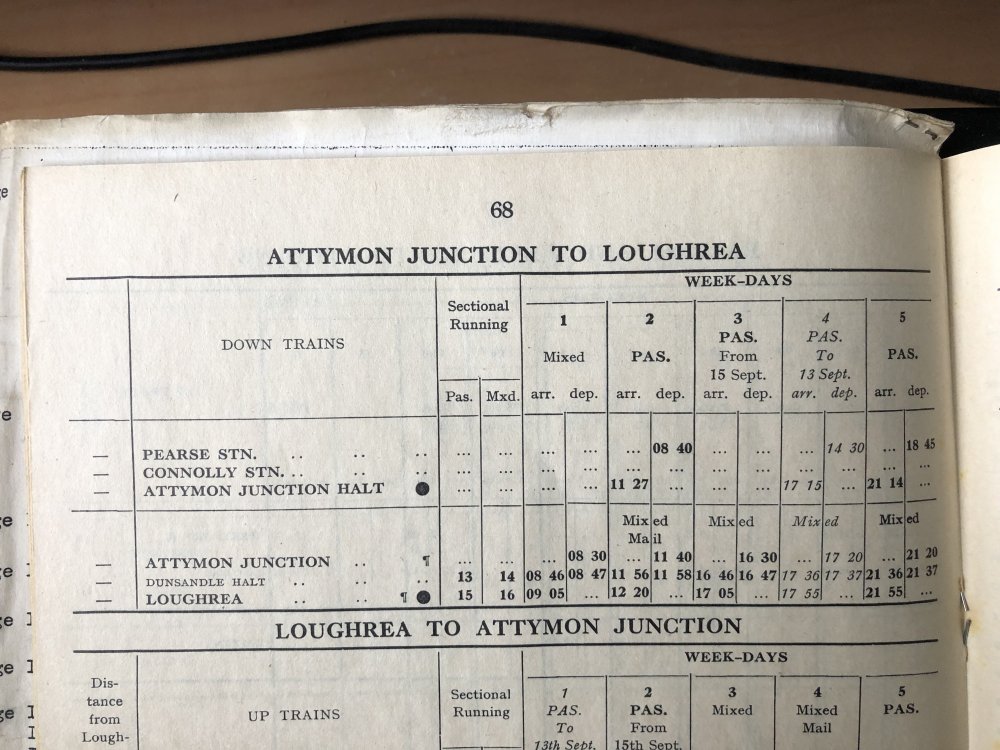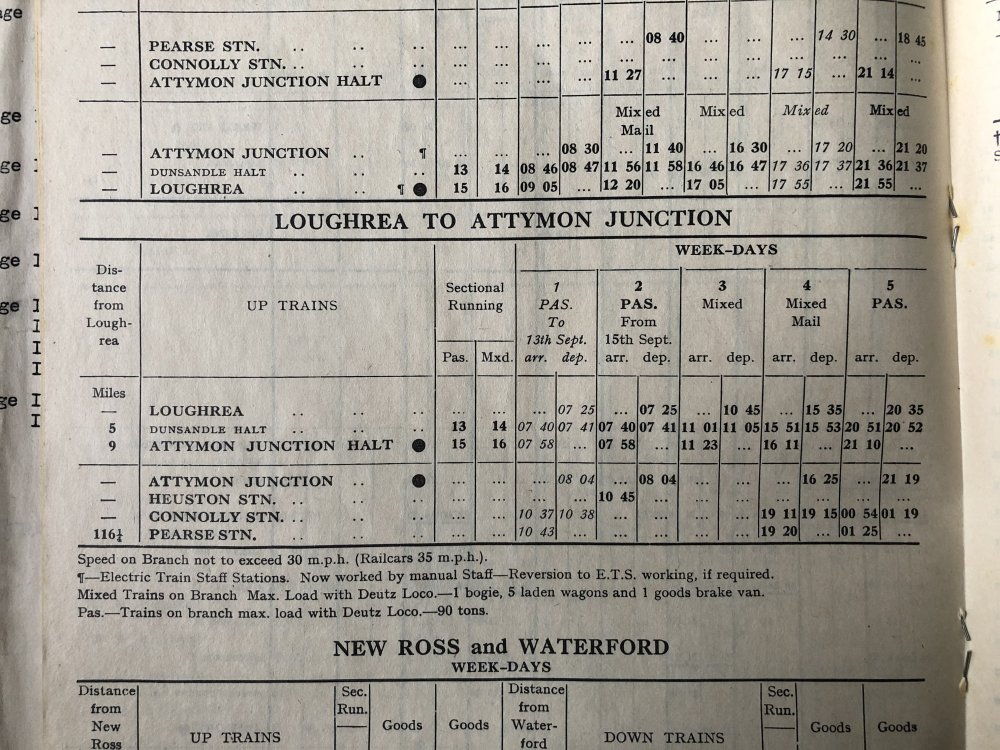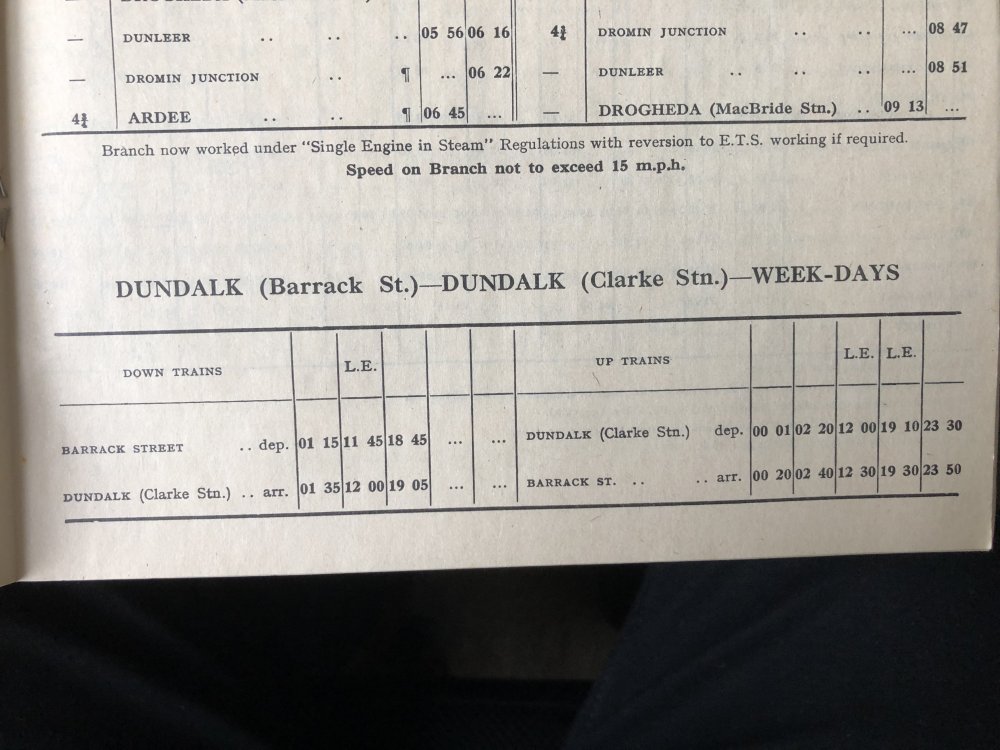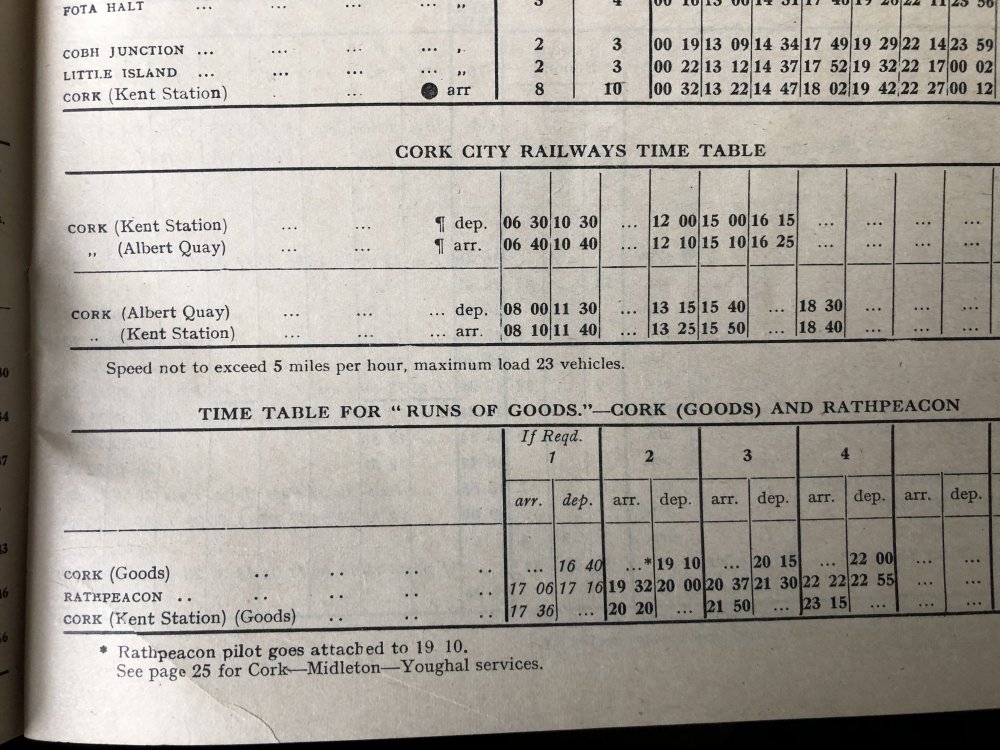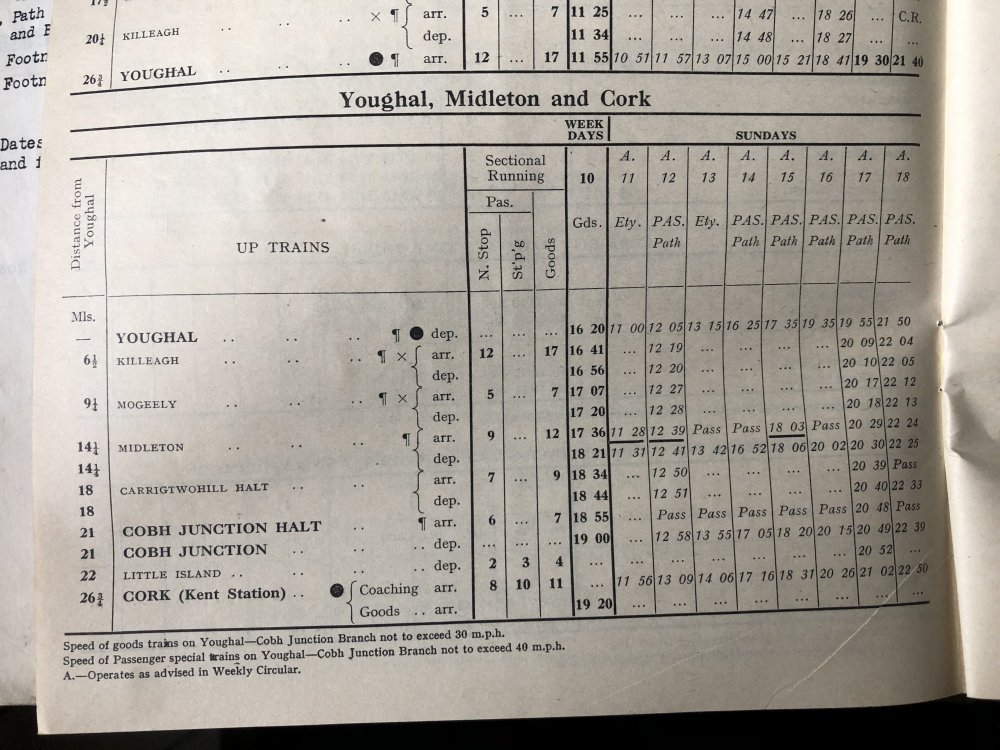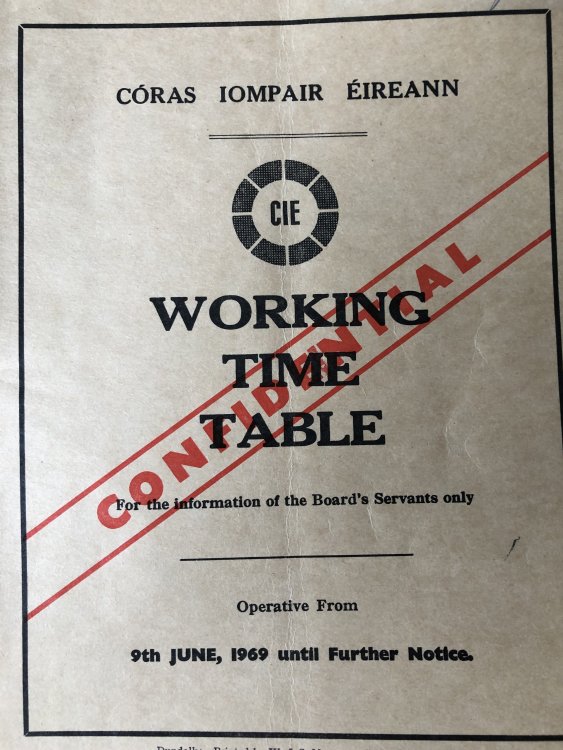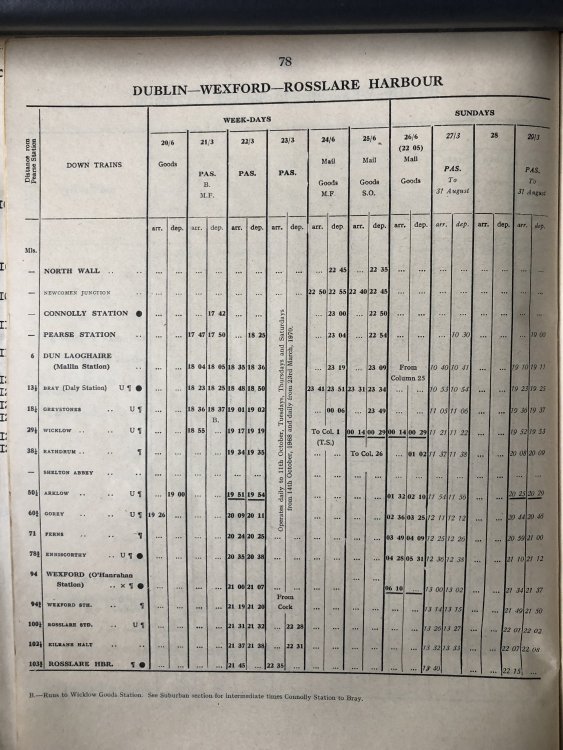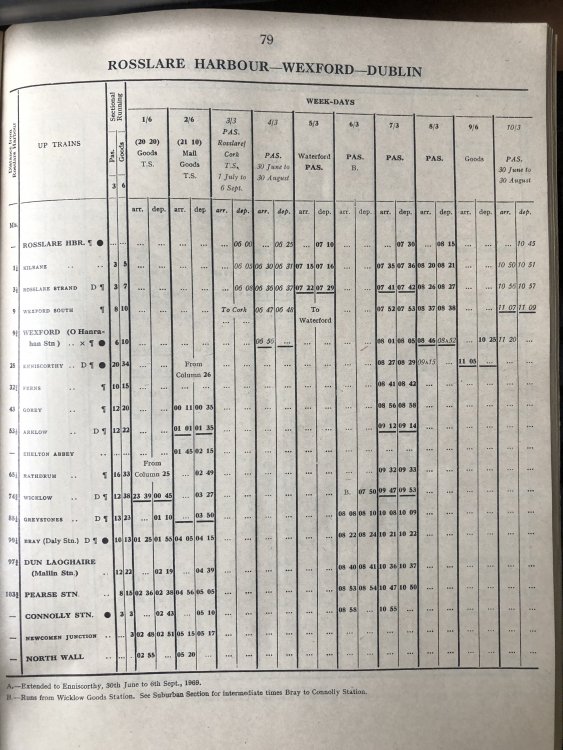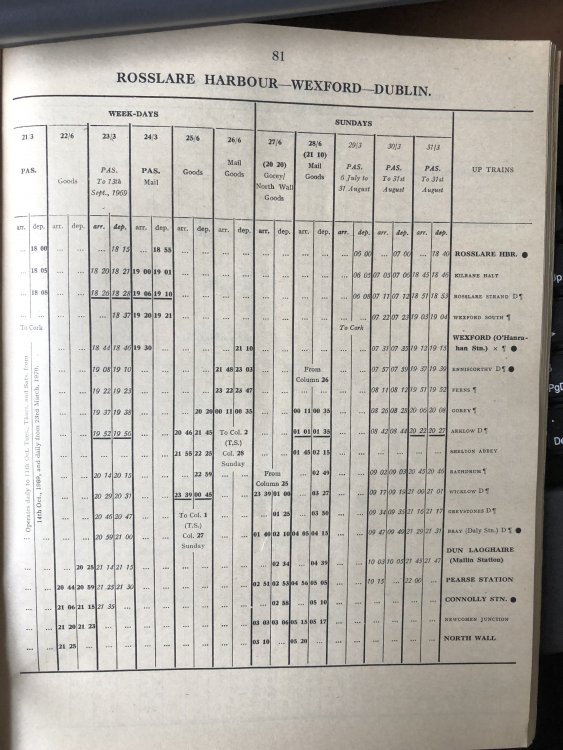-
Posts
15,934 -
Joined
-
Last visited
-
Days Won
394
Content Type
Profiles
Forums
Events
Gallery
Blogs
Community Map
Everything posted by jhb171achill
-
Indeed, DART811. Illustrations of relevant tables for Dublin - Galway, Westport, Ballina and Sligo to follow. Yes, it was made of sections. Among my favourite railway memories are of travelling on the return version of this from Sligo one evening, leaving there at 18:10, I think, and arriving into Connolly at 01:25 or so, after a lengthy wait at Mullingar (an hour, awaiting the up Galway portion). Up front were two 121s, the numbers of which I forget. the train consisted of an elderly brake standard, converted from either an old Bredin or a 1951-series CIE build to the same basic design. It had three side corridor compartments at one end, and the rest of it, some two thirds of the coach, was a giant parcels / guard / mail van. Next was a bogie mail coach, then a tin van, plus several other fitted vans of various types. Three passengers boarded. I had come up from limerick that day on the solitary Limerick - Ballina departure as far as Claremorris, thence by old "E" class bus to Sligo. I missed the last train of the day (there were only three) to Dublin, so i went on the mail, which wasn't even advertised. It was sunny summer day, but as we approached Sligo it was clear it had been raining - the ground glistened in the evening sun, and black clouds vied for space in the firmament with blue sky and bright sun. One passenger got off at Collooney vanished into the evening sun to a waiting car. The other passenger drove me mad. A tall, angular man, with wild grey hair and a long black coat, he wandered up and down the (short!) corridor, mumbling to himself through a thick moustache that could have comfortably been called home by a sizeable community of rabbits, mice and pine martens. His coat portrayed a vivid canvas of remnants of the last six months' dinners in stained cameo down its front. He came into my compartment. Why mine? There were three others. As the evening sun lengthened into shadows, I pretended to be asleep. If it was today, I'd pretend to be a "furriner". Me no speekee no eengleesh. The train stopped at every station to load and unload mailbags, cartons of washing powder, a lawnmower, and dear knows what. As the sun set over the boglands of Westmeath, we eventually arrived at Mullingar. My companion wandered up and down, mumbling as he went without break, and sticking to my compartment, or wherever I tried to go to, as his last few hang sangwidge remnants stuck to his moustache and shirt. Fifty minutes at Mullingar were required to await the up Galway mail. It arrived with one 141 up front. Some shunting ensued, and eventually we were off, at about midnight. After several stops in the dark (signals? Crossing goods trains? I don't know - I was very sleepy now - irrespective of the Mumbler - arrival in Connolly (or was it Westland Row?) was about 01.25. Mumbler exepted, I'd love to do it again. One of my only two nocturnal mail train journeys in Ireland. The other was less eventful, and I was the only passenger out of Galway. Timetables follow, which should throw light on your query. This is the 1960/1 WTT.
-
The all-white roundel only ever appeared on newly delivered 071s, Divecontroller. All roundels on all locos without exception were transfers, with a tan "broken wheel" and white lettering. Variations appeared on buses but never locos. This transcended the black, black'n'tan and supertrain livies 1963/4 until 1987 when the new IE "set of points" logo appeared. On a brand newly painted loco, in any period or livery mentioned above, the tan on the CIE transfer looked very slightly less "orangey" when new, and often faded somewhat, leading assumptions to be made that it was, in fact, a lighter almost beige colour. Not so, though. Thus, when the "supertrain" livery came out, there appeared to be a far greater contrast between shades than was actually the case. This was entirely due to our old friend, weathering. A bit like the "silver" laminates, A, C, E, and B101 locos, and tin vans - they looked "silver" about ten minutes into their first journey, then dirty light grey thereafter! Or white wain numerals or logos - nothing, but nothing, ever painted white on any railway vehicle stayed that way long..... So only the one colour of CIE logo - though a "weathered" version of this and many other logos, if commercially available, would greatly add authenticity to many models.
-
Interesting train, illustrating perfectly the point that I make elsewhere quite often - that in the pre-1970 times going way back, in both goods and passenger trains barely two consecutive vehicles were alike. Behind the loco - a non-corridor third of approx 1900-05 era, either GSWR or possibly DSER in origin in GSR maroon; a brown and cream MGWR composite (prob 1st / 2nd); a maroon MGWR six-wheeled third; a brown and cream GSWR third by the look of it, and various horse boxes and fitted vans. The GSR initially used the same extremely dark browny maroon known as "crimson lake" (though it was about as crimson as an apple!) as per GSWR, just different markings. The brown and cream, same shades as the English GWR, starts appearing in the late 1920s but is confined to main line stock. From 1933, LMS shade maroon (with identical lining, as seen in the first coach) becomes the norm for the rest of GSR days. The loco, of course, is all-over dark grey.
-
Sure what would the English know! Yes, while "Maedb" was a queen, Macha & Tailté weren't! Had another two been built, they would have been named after non-queen personalities too. The "Kerry Bogies" were usually to be found on Mallow - Tralee, hence the name. I think they were Ireland's first 4.4.0s, certainly among them. Not disputing the Hampshire label - just I never heard it despite living in Lisburn. Forgot about the "Bandon Tanks". Pity one didn't survive, though with its coal capacity it would be useless in main line use. But good in a museum, provided they could be bothered to paint it correctly. They'd probably have it in maroon and tartan, with a yellow chimney........
-
Correct! And then there were the MGWR / GSR "Woolwiches" and NCC "Scotch Engines" - both named by railway staff. Somehow, I seem to take railway staff nicknames more seriously than those given by teenage gricers! The D16s were known as the "Achill Bogies" as the six of them ended up there, rarely doing anything else as they were very underpowered.
-
The roundel, white letters surrounded by tan “broken wheel”, appeared as soon as locos were repainted from green. But here the plot thickens. Initially, the idea was Black and Tan locos with the number on the sides and ends, same size and style as in the green livery (but white instead of eau-de-nil). But before they were all repainted from green, some started appearing in all-black with white flashes on the ends only. Same numerals. THEN - I’d say about 1965, the “broken wheel” logo appears, and from then on whether the livery is all black, black’n’tan, or later “supertrain”, it stayed the same. Like the former flying snail, they were all standard transfers. Because the “supertrain” livery looked so bright, the broken wheel looked duller but it was the same. I remember comparing a newly painted loco in “supertrain” with a good clean black’n’tan loco alongside on several occasions. The 071s had white roundels when new but these were non standard ones applied in America, with their own unique larger dimensions and incorrect proportions. They were replaced on first repaint.
-
Now, boys and girls, once you’ve read all of the above, please tear off the slip below, sign it, and send it to York Road. And MAKE SURE that when you’re loading cattle trucks on the Derry Central, that you put the Protestant cattle and the Catholic ones in SEPARATE cattle trucks.
-
Now we’ll move north to the Bann Valley and the beautiful Glens of Antrim.... Now to the timetables. It’s summer 1939, the Indian Summer of the NCC, when York Road to Derry took just over two hours, and the non stop Belfast to Larne Harbour boat train took HALF an hour - and this was almost ten years before the Jeeps were invented....
-
Many thanks, Edo. I have a pretty large collection, and as you suggest once I go to that Great Locomotive Shed in the Sky, they will go to a good home. An attached condition will be that they will be available for all to see, not secreted away and hidden from all but a small chosen few, as are some things donated to some archives. I thinned the collection out considerably a few years ago, but I retain some GNR, NCC and narrow gauge, SLNCR, and most of the GSR / CIE from 1926 to 1986. I must confess that nothing much on the railway since 1986 interests me in the slightest! I think that can be said for many of us who (a) remember steam and flying snails, loose coupled goods trains and branch lines, and (b) have seen a 60th birthday fade into historical oblivion! Mind you, I know one very fresh 82-year-old who could give you chapter and verse on ICRs! I agree with you about the comparative irrelevance of railways in rural Ireland nowadays - true, but a pity. If Dublin wasn't choked with traffic it would probably be the same here too. If there's anything else that interests anyone, gimme a shout.
-
Finally we move on to what was about the last timetable to feature regular steam. While Mountmellick is now worked by a “C” class, usually with an old GSWR wooden bogie and a new “tin van” doing passenger service, the Banagher branch had a G601 and was goods-only, while was worked by a Midland 2.4.0 or 0.6.0, the passenger set usually an old Midland 6-wheeled brake, with another old GSWR bogie. Ardee has its daily goods, by now usually an A class, though I wouldn’t be surprised if a GNR 0.6.0 might still have been about. The C class weren’t really seen on the GNR then. At Edo’s request, the North Wexford line and Dublin - Waterford services too.
-
Back in time, this is for Edo. The Waterford area including Dublin trains and the DSER branch. This is 1957-8. The first page creeps in, out of interest; a quiet day at the office on all these lines, still technically open but seeing nothing but field mice in regular traffic, and the odd cattle or GAA special.... Above of interest to anyone doing a late 50s / early 60s branch. In this case it was at that stage worked by a C class.
-
This one was missing from above. Now, we’ll look at 1976. Not much different, and the Castleisland line closed (from memory) about April that year.
-
It’s 1970 and we’re deep in Kerry. Black’n’tan (and black!) locos are everywhere. No “supertrain” will be heard of for a couple of years. The “Swinging Sixties” fade into history, as do the sanctimonious John Lennon and his Oasis tribute band (or was it the other way round?)... All passenger stock in normal use is of the Laminate, Bredin, Park Royal and Craven type. They all run mixed up. There are a few old GSWR wooden bogies still in spare use in Cork (and Dublin). On summer excursions they still make an occasional appearance, mixed in with the rest, of course. All goods stock is grey, though a few brake vans and a few covered vans are reported to have been seen in a new all-brown livery. Also, some of the new cement wagons are being repainted orange and grey. And here’s what’s to be seen on the daily North Kerry goods, and the few “as-required” trains on the Fenit and Castleisland lines. And not an ICR, digital display or a yellow hobs machine to be seen, let alone graffiti and lineside discarded mattresses and shopping trolleys.... Gawd be with the days. Ending with some goods trains in Cork to show what was going on....
-
First 22000 set fully refreshed
jhb171achill replied to thewanderer's topic in Photos & Videos of the Prototype
Must say the new interior looks to me to a bit of a hotch potch, given the closely co-ordinated look of the interior of coaches today. The upholstery, tables, wall sides and carpets don't even begin to co-ordinate; compare this with the refurbed "Enterprise"....! Still, if they add some system to stop the toilets smelling, and circulate fresh air, and keep the temperature below 30 degrees inside, it'll be a big improvement! I have to say that apart from the above, they're not the worst things to travel in. If I must choose any modern railcar, I'd go for the NIR 4000s. They (plus the ICRs) are quiet. The old ones, especially the tractor-engine MED cars, were absolutely atrocious. You'd need a gas mask to avoid the diesel fumes, and earphones to stop you going deaf in those oul things in the 1960s! "Hellfire" and "Thrash"....no, thanks! -
Not necessarily most, but I would say probably. Railway staff were responsible for many too, e.g. “Jeeps” for the NCC / UTA “WT” class 2.6.4Ts. The GSR renumbered one of the Midland G2 2.4.0s as No. 666. The railwaymen called it “The Beast” after the passage in the Book of Revelations in the Bible which speaks of the end of the world, and the “number of the beast” is apparently “calculated” as three sixes. Some drivers considered it bad luck to drive it. In modern times, the 2600 railcars were “Fanta Cans” initially, then to a few they were “Lilt Cans” when repainted navy and lime green. Which probably makes them “Diet 7-Up Cans” nowadays! When new, I heard the 201 class locos referred to as something to do with yellow, or bananas (flying banana, maybe?) on account of the yellow stripe on the side and the yellow ends....
-
A very good tip for us all, especially given the extremely high standard of the scenic work of Fintonagh and Arigna Road.
-
Next year they’ll have a cabinet filled with ready to run Midland six-wheelers, and J18, C2 and D16 class locos, and RTR “Jeeps”! Thats what I dreamt last night anyway.....
-
I'll do that one too, Ed. There's a thread I started a couple of years ago on this "Extracts from old working timetables". I did this partly for general interest and partly because I find old timetables a good info source for layout planning. Since this thread started off as the DSER section specifically, I'll post other lines on the above one. Maybe the admins can add a link to it here?
-
Certainly - will do that today, if the "Voices" let me........ What years? The branch closed in 1976 as far as I recall. I'll do maybe 1965, 70 & 74 - though the picture is the same; one goods train a day, Monday - Friday, with an occasional GAA or pilgrimage special. The track plan there was quite simple and compact and very suitable for a layout. You can imagine it lasted into the 1980s, and had a twice-daily (push-pull) passenger service to Tralee. Goods by then would probably be Guinness and fertiliser if you want modern era. Since this is headed "DSER timetables" I'll post separately.
-
New one to me, Lambegman, but there ye go! Wouldn't have been common, I suspect. And, like you, I never heard the other yokes called "Rivers". Railwaymen all over tended to refer to numbers in most but not all cases. The three Hunslets were known as Hunslets or 101s, the railcars were inevitable 70 or 80 class among railwaymen, but the 450s were also called "Castles". The MED, MPD, BUT and AEC cars were called just that. On CIE, railwaymen almost inevitably used the GSWR terminology, not GSR - thus a 101 class instead of a J15, a 400 class, 500 class, 800 class, 60 class etc etc...
-
Did you see the timetables I posted earlier this evening from 1980 and 1986 under "General Chat"? They might be of use to you. No reason why the Ballina branch at some stage then wouldn't have been a 121 with a PP Mk 3 - the Limerick Junction branch set was..... Such a set, I like to think, could have kept the Waterford & Tramore going, had it survived, until the 2600 / 2700 railcar era...
-
The NIR “C” class we’re officially designated MV class. The 70s were called “Rivers” by perhaps a handful of enthusiasts, but as for “Hampshires”; I knew one enthusiast who occasionally called then that! (You may know who I mean!).... In Britain the Southern Region ones as opposed to our ones, were called Hampshires.
-
I’ve Youghal most years 1926-86 if you’re interested. Indeed, I’ve most lines over that period. Not so much GNR nowadays as I donated a good lot to various museums, mostly Enniskillen.
-
A few other gems from 1969. The first few are excerpts from the Tralee - Mallow timetable, just to show Castleisland (and its summer excursion train path) and the “if required” path to Fenit. Black’n’Tan heaven....
-
And finally, 1969. This shows the contrast between the one-use, one-type-of-wagon, one-customer (or maybe 2!) fitted liner trains and the much more varied (and interesting!) all-purpose goods trains, which will have everything from corrugated opens to H vans, palvans, four wheel flats with containers, etc etc. And what was IN them even more varied. Everything from soap powder to beet, engineering equipment, TV sets, sand, timber, parcels, newspapers, cans of mushy peas in cardboard boxes etc etc etc.
.png.c363cdf5c3fb7955cd92a55eb6dbbae0.png)


